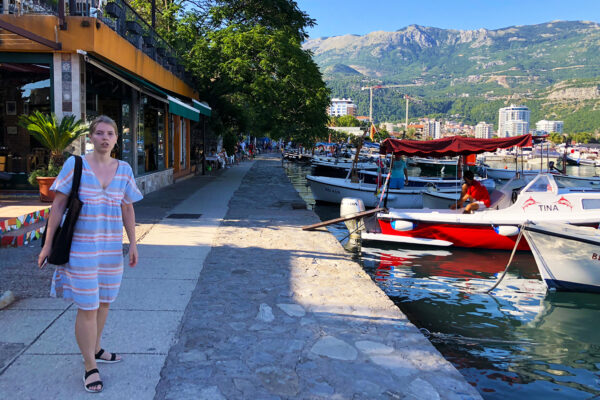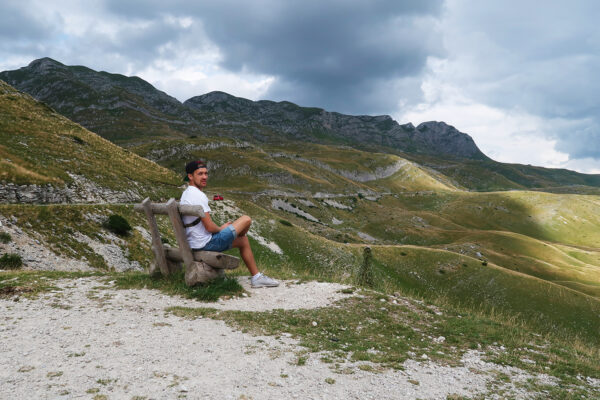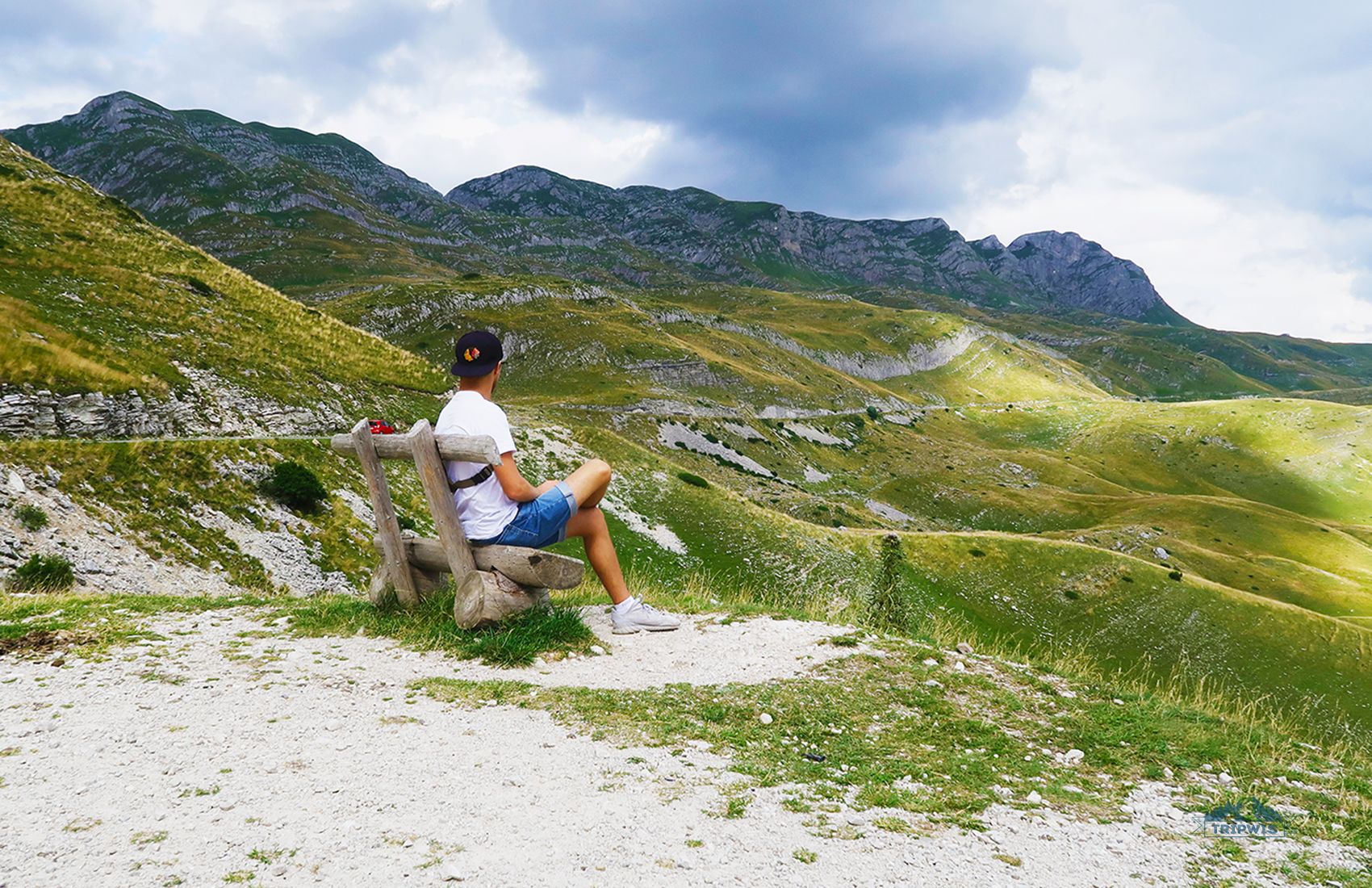
What has long been Europe’s top secret is now one of the hottest destinations of the year — Montenegro should be on top of everybody’s travel bucket list in 2025. Majestic scenery, chic coastal boltholes, ineffably mysterious ruins, and overall feelings of tranquility and charm, — that’s what Montenegro is all about!
Our time in Montenegro has helped us create this amazing travel guide: Get a pen ready, because you’re about to read an exhaustive list of things to know about Montenegro, spots to bookmark, and activities to plan. Here we go!
Article contents
- What do tourists need to know before going to Montenegro?
● Great view is the norm here
● It’s the Balkans, not Europe
● Superior safety
● Lower prices
● Mom-and-Pop style
● No major chains
● What to eat in Montenegro?
● Where to eat in Montenegro?
● Get off the beaten path
● What is the best time to go to Montenegro?
● Best areas to stay in Montenegro
● How many days is enough?
● You may want to rent a car in Montenegro (it’s rather cheap anyways)
● Planning your budget for the trip to Montenegro - What are the do’s and don’ts in Montenegro?
- The final word and the final “Don’t” of Montenegro
What do tourists need to know before going to Montenegro?

There’s no surprise that all of the most basic travel guides online will give you nothing but a bunch of underwhelming facts about Montenegro:
✔️ It’s the smallest country in Eastern Europe,
✔️ the least populated,
✔️ the youngest,
✔️ and an all-around budget-friendly destination.
All points assume there’s not that much to see here, or, perhaps, that a week-long trip is enough to cross it from your “places to visit” list. Sorry to break it to you: It’s an illusion. This description is outdated and at times blatantly wrong.
Of all things to know before traveling to Montenegro, this is the first most important one: Do not underestimate it (the second one being “Bring an umbrella”, but we’ll get into the deets further down).
We (my wife and I, both in our late 20s) have been here for over a year now. After 16 months of living in Montenegro, with almost every weekend being a new location and a new adventure, I can confidently say we haven’t seen it all yet. It’s bigger than it seems.
In this complete Montenegro travel guide, we’ll focus on both the peculiar vibes and all the practical aspects of this location. We hope you enjoy!
Great view is the norm here

First, let’s talk about expectations. Every single country has some lovely views and iconic locations that are suitable for promo videos or tourist flyers. The fact rings true for Montenegro, but in a different way: A great view is the norm here. You don’t have to go out there and look for it.
It’s not unusual to drive somewhere, stop in the middle of the road, and see a stunning panoramic view of either a towering mountain range, azure sea, expansive valley, or the picturesque Bay of Kotor.
- Pick a middle-of-nowhere location that’s not even marked on Google Maps, and chances are, it’ll have a great view. It’s just normal.
This pretty unique phenomenon seems to be a natural result of the country’s geography: Montenegro is ALL mountains. It’s no secret either — the name is a dead giveaway. Montenegro translates to “Black Mountain” but the ranges here are actually green and orange-gray-ish; with other color palette-determinators being both pine trees and palms lining the coast (sometimes next to each other, which can be trippy) and rocky limestone cliffs in the distance.
This beauty can be arresting, so that’s why we put this point first on our list of things to know before traveling to Montenegro. For once, you CAN trust what you see in pictures online. Even those posted on the organized tours services:
It’s the Balkans, not Europe
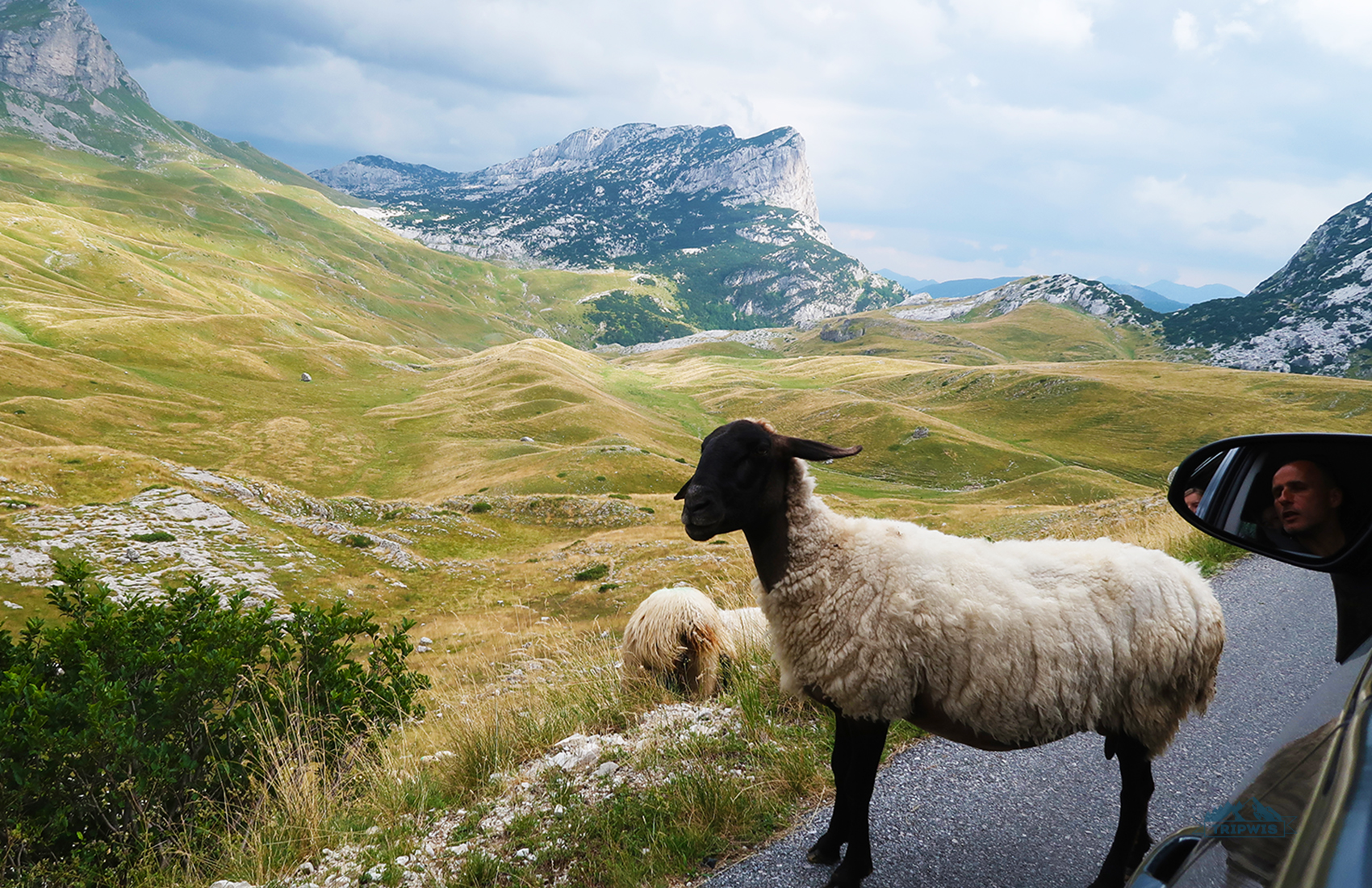
This will be a short one: Geographically, Montenegro is considered a European country. But it’s not. At least, it’s not truly Europe yet (it is a candidate to join the European Union, though).
Is it a good or a bad thing for a fellow traveler? Hard to tell, but the hordes of holidaymakers flocking like birds to Montenegro in summer will tell you that it’s not a thing many worry about before coming here. The Balkans even sound more special, attributing to the country’s overall appeal.
Superior safety

Upon first getting to Montenegro, you’re bound to notice that the country doesn’t have the pressing issues of modern-day Europe, at least in the sector of public safety. There are no scenarios like drug-selling gangs policing the streets like those in Barcelona’s La Rambla.
We live in Budva, Montenegro’s most populated city on the Adriatic Sea and the de facto tourist capital. The streets here are clean, and you don’t have to wear your Chanel bag in “safety mode” while out and about.
In fact, safety in Montenegro is FAR superior to what I’ve seen in bigger, more popular and economically more developed countries, and it shows:
- If you forget your bags somewhere, no one will touch them;
- If you lose your wallet, you’ll find it at the nearest “kiosk”;
- And if you’re afraid of someone stealing your phone right from your pocket, you’re, most likely, wasting your nerve cells for nothing: It barely ever happens.
Still unsure about being completely safe here? I have an anecdote that will change your mind! Here’s one of my favorite interesting facts about Montenegro:
Compare this scale of issues to any other place. Would an ATM break-in attempt even get any media coverage in, say, Milan? Would a “gang” of teenagers be Istanbul’s main problem, enough for officials to step in? I doubt it. And that’s the scale of the local “crime scene.” Montenegro is the place where Your Friendly Neighborhood Spider-Man comes for a vacation, since there’re no jobs for him here.
Lower prices
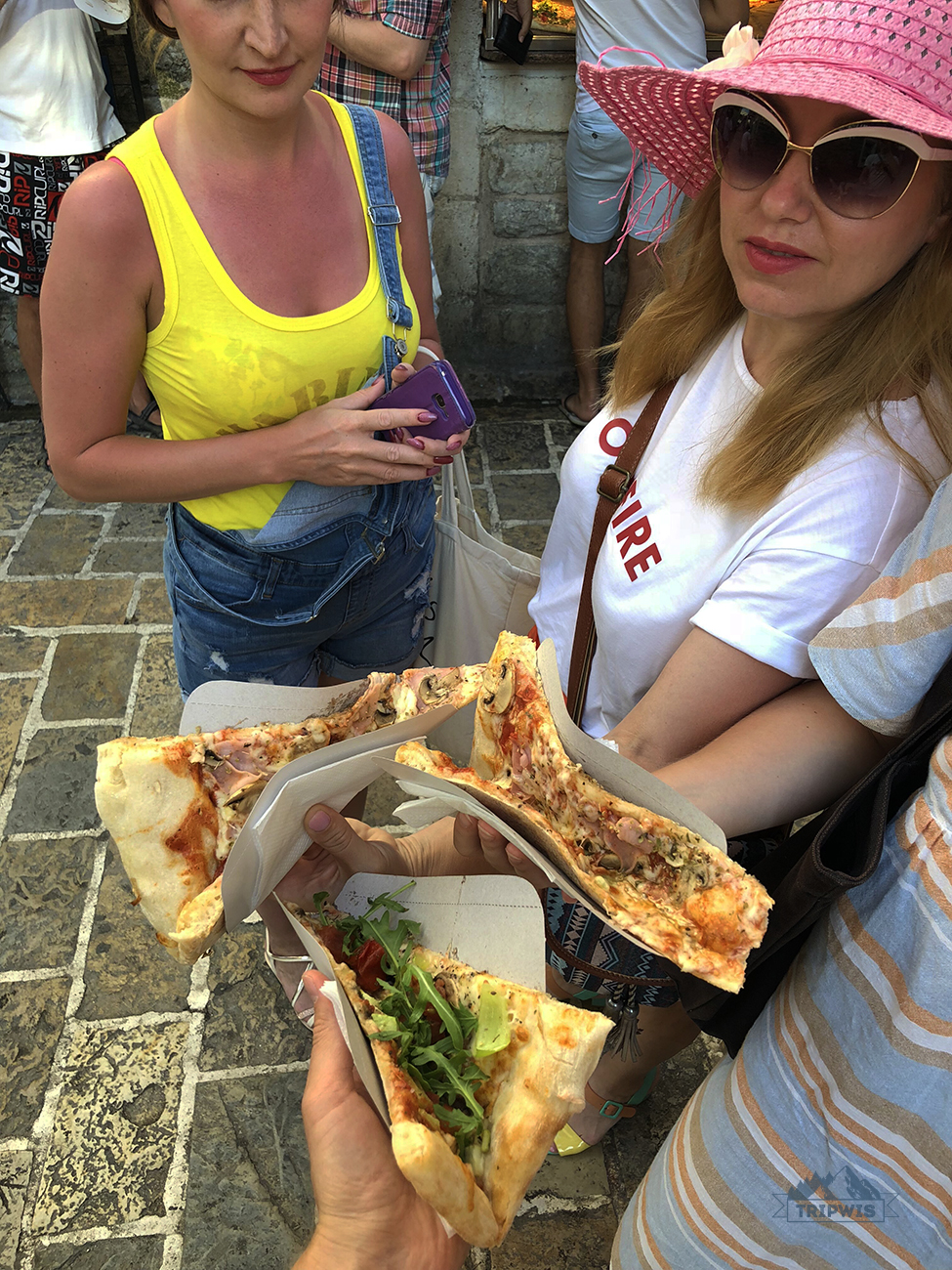 |
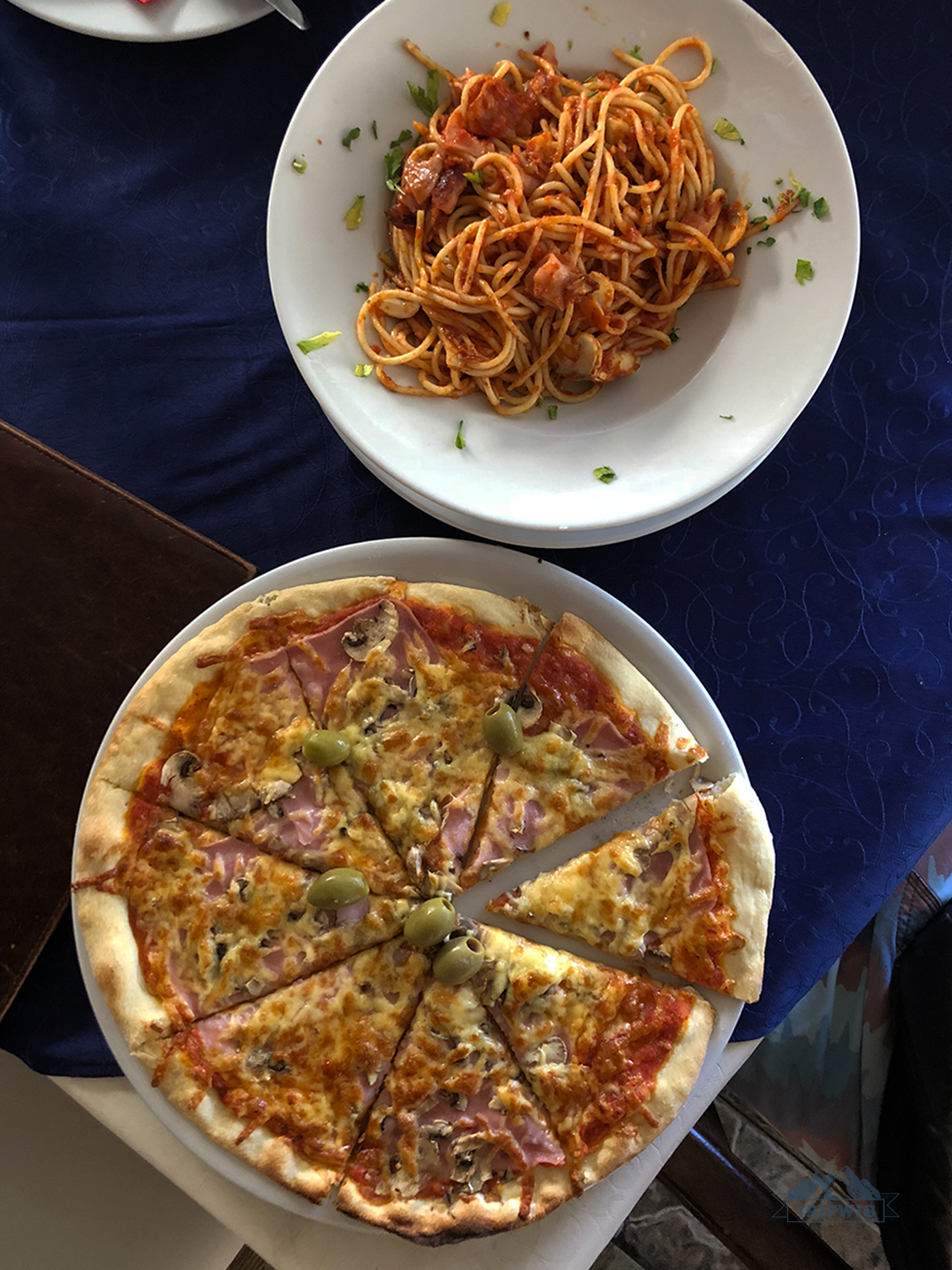 |
Montenegro is significantly cheaper than most of Europe (it definitely wins by a landslide when you choose between Montenegro or Croatia — the usual dilemma of a fellow traveler). Don’t get me wrong, you absolutely can spend a lot of money here, you’ll just find it more challenging at times.
Travel “basics” are pretty easy on your wallet in Montenegro:
- Accommodation? About three times cheaper than more popular European destinations;
- Food? Two times cheaper, with enormous portions;
- Entertainment? Mountain trails and sea views are free, and there’s nothing much else to do here.
Posh and expensive places exist in Montenegro, but you’ll have to look for them. You can stay in Porto Montenegro, Tivat’s luxurious neighborhood (which is about three blocks long), but that’s basically it. In Budva, there are three or maybe five places with above-average prices. Elsewhere along the coast, you’d have to try even harder.
Mom-and-Pop style
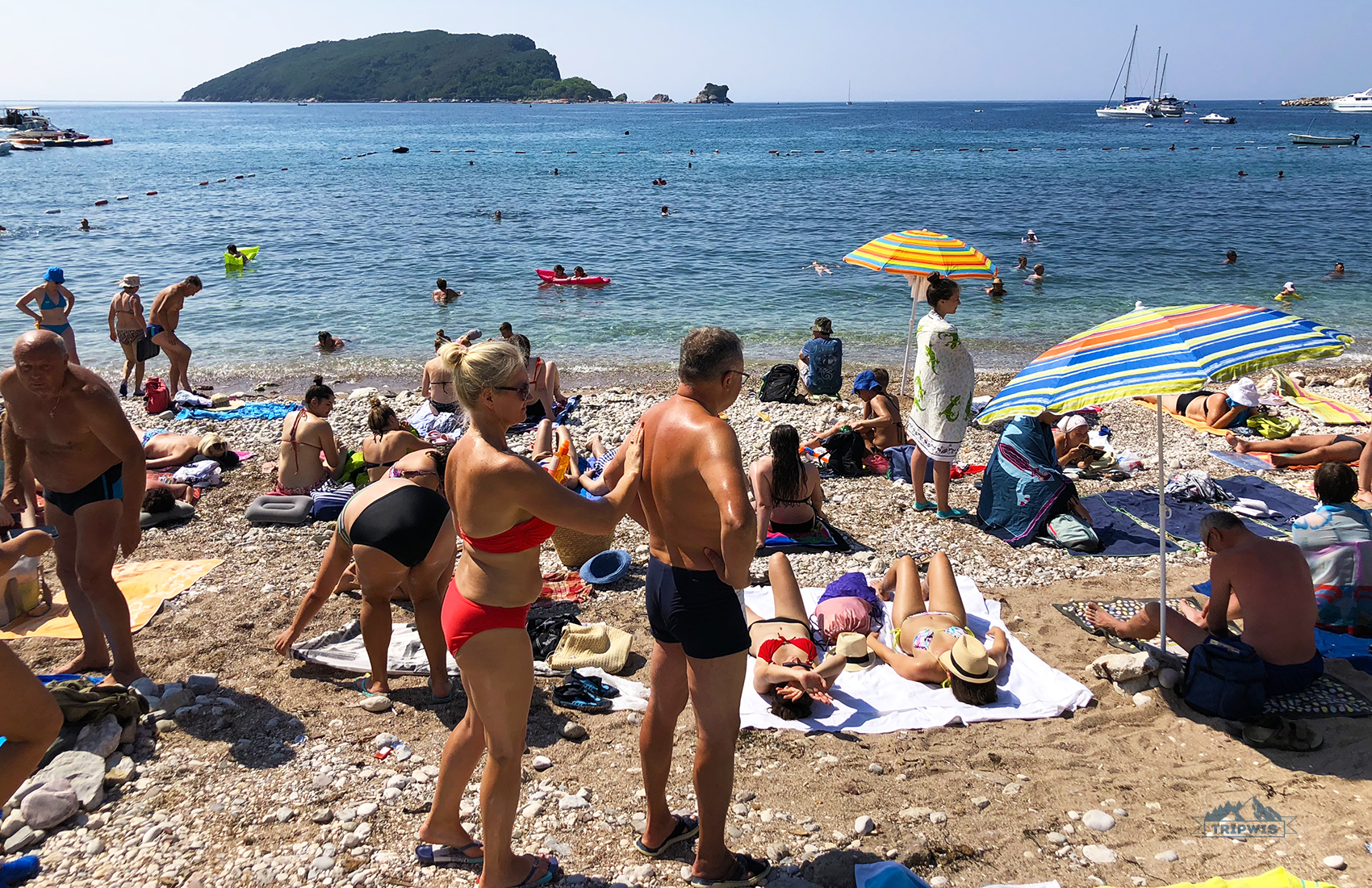
Most local businesses in Montenegro are family-owned. If it’s a hotel, it will most likely be owned by the family that lives in the same building. Bars and restaurants? Same thing!
- You’ll notice it in shop signs — almost every business’s board has an asterisk with “since 1990-something” and some are still very closely associated with a family name.
Most notable locations are no different: Jadran bar belongs to the Niklanovic family, Sova restaurant — to Vujosevics, and so on. One of the best places to get coffee in the whole of Montenegro, the Casper Bar, has been run by the same family for over 30 years now!
The slow pace of local business affects the longevity of these establishments, and it checks out. In most places (excluding tourist trap ones that open exclusively during high season), you’ll see that people actually care. They are not being pushy about it either: The Balkan character means no bargaining, tempting with discounts, or coaxing you to enter the business by any means necessary. They know that the quality of the services provided will speak for itself!
No major food, retail, and service chains
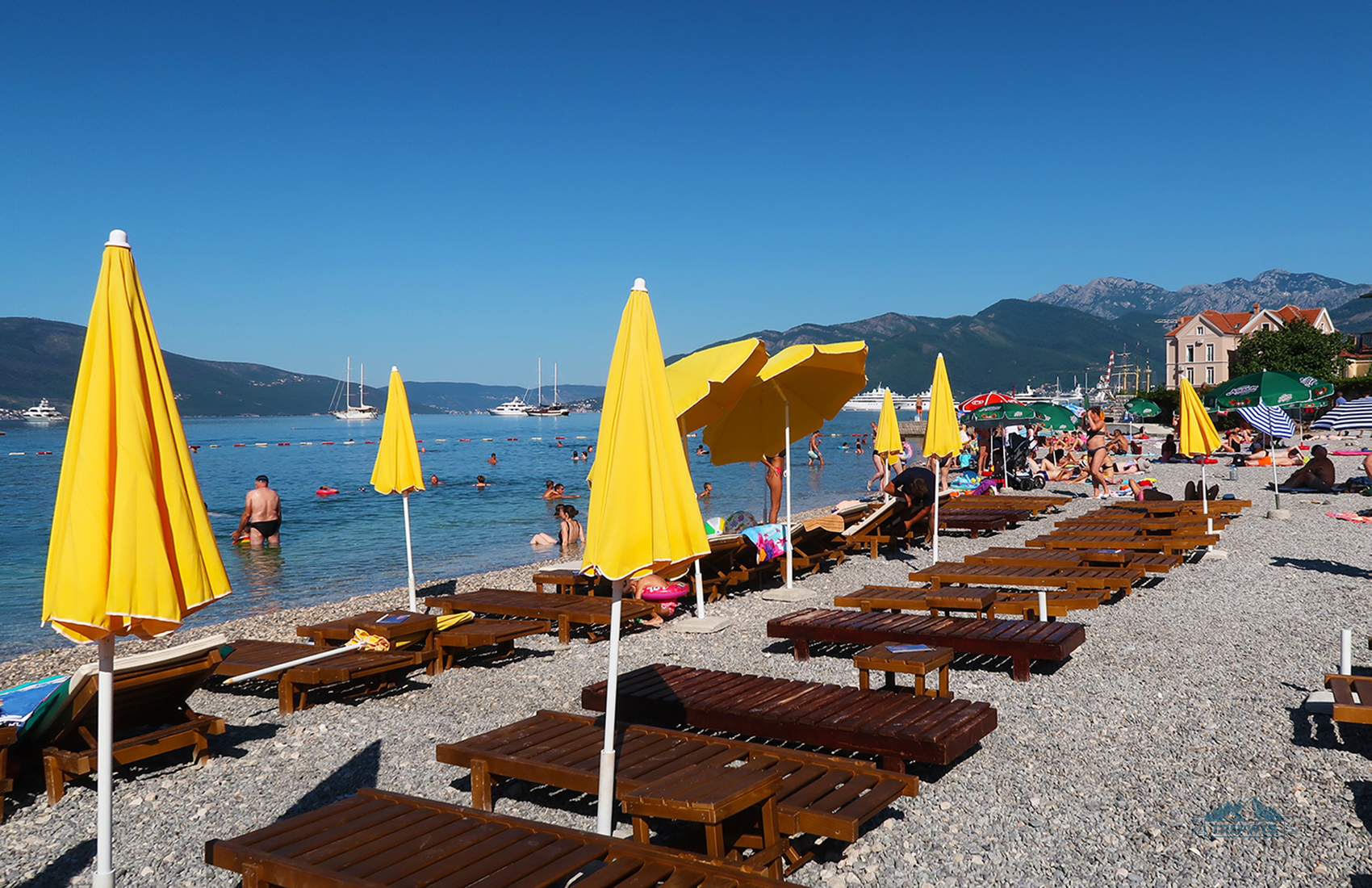
If you’re a type of globetrotter that expects a new place to have the same comforts that you have in your home country, this is one of the most important things to know before traveling to Montenegro.
Brace yourself:
- There’s no McDonald’s in Montenegro;
- There’s no Burger King (the one in Podgorica is not really a Burger King; it’s extremely overpriced and lacks in quality, even by junk food standards);
- No KFC (the nearest one is in Bosnia, hidden between car dealerships and a gas station in Mostar, and it’s plain bad as well);
- No Starbucks. Not a single one.
There’s also no Uber or Uber Eats in Montenegro. To get a taxi, you’ll need to use Viber or What’s App, and to get a delivery, you’ll have to use Glovo — a far less organized service.
The only place suitable for a somewhat decent shopping experience is Big Fashion Mall in Podgorica. It’s smaller than an average Walmart, with mostly off-brand stores and an occasional small Zara in the corner.
Most travelers consider this lack of big name brands and overly automated services a good thing: You get to experience a new place in all its raw authenticity, without the veil of “fast” anything — be it food or fashion.
No European standards
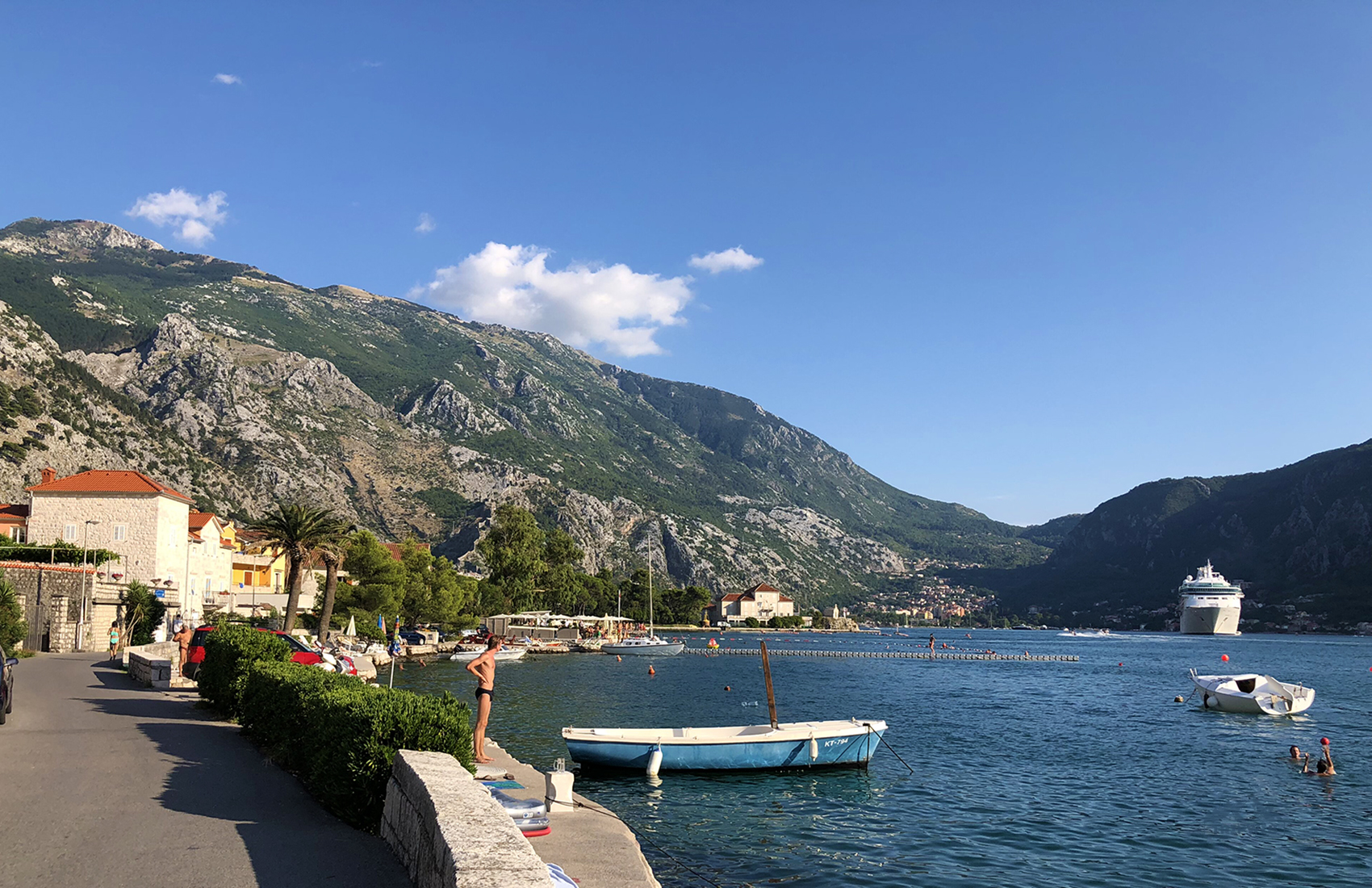
For me, European standards of service (for example, in a restaurant) stand for speed and aesthetics of the process. If it’s breakfast, I want it quick. If it’s dinner, I want it fancy. While it’s possible to find something like that in Montenegro, it’s not easy. They’re trying, but they’re not quite there yet.
The local service is, to put it simply, chill:
- Get ready to get your food later than usual if the waitress decides to gossip a bit with the bartender;
- Get ready to see the cheese in your pasta scattered all across the plate in massive slices if the chef is busy watching a football game on TV.
In other words, be prepared to wait and don’t expect your food to be served in accordance with Micheline standards.
Pro tip: When you first come to a restaurant in Montenegro, it is expected that you’ll ask for a drink right away, so that you can sip it while waiting for the food. Because the process of ordering happens pretty fast, it’s good to know the approximate prices for beverages in Montenegro:
— Coffee costs about €3 everywhere, regardless of the average meal price of the restaurant;
— Same goes for tea (about €2 – €2,5), water (about €1,5), and fresh juice (€3 – €5).
Speaking of local food — what to eat in Montenegro?

What is Montenegro best known for, food-wise? Well, it definitely can be considered a prime foodie destination — local cuisine here benefits from thriving nature and eclectic influences of the neighboring countries.
And while the local dishes are unquestionably delicious, it is their size that will make you have doubts: Not in the food itself, but rather your abilities. One portion in a restaurant in Montenegro is almost always enough for two. Specialty plates “for two” are enough to feed a company of four. And the prices are even better — these ginormous portions cost less than half of what you’d pay in a restaurant in another country.
The world of traditional Montenegrin dishes is a wild and vast one for sure. To help you navigate, here’s my list of top-five local foods:
- Shopska Salad
As simple as it gets (some chopped tomatoes, cucumbers, onions, and peppers), but it’s the cheese that makes it special. Shopska salad is always topped with a generous amount of sirene cheese, which is a brined cheese similar to feta.
- Ispod sača meat
It’s… well, just meat, but cooked under a sač*, and that makes all the difference. Sač is a bell-like dome that makes whatever meat it is (lamb, chicken, or beef) super tender and juicy, with a hint of smoky flavor.
*By the way, if you struggle with the pronunciation of “č”, just go for “ch.” Sač is pronounced exactly like “such.”
- Burek
You know how they say that gin creeps up on you? While you drink it, especially with tonic, you barely feel drunk until you try to get up. Well, a traditional burek does the same, at least in some capacity (no intoxication involved).
Burek is a pastry, with thin layers of dough, aka phyllo, filled with cheese and spinach. It’s so airy, layered, weightless and savory, that you can’t stop until you realize it’s too late. Bureks are extremely high in calories, just as much as they are delicious.
- Pljeskavice and Ćevapi
I’m not going to divide these into two separate categories like most other blogs do: They’re essentially the same thing, just in two different forms.
Pljeskavice is a large patty made with a blend of pork, meat, and lamb. Ćevapi is practically the same blend but in small rolls and with a different set of spices. With both, you’ll usually get a whole load of fries, some vegetables, bread, and a variety of sauces to choose from.
Don’t try to order both at the same time. You’ll usually get 10+ ćevapi on a plate “for one,” and the size of an average pljeskavice is worthy of a “Monster Burger Challenge” in some boondocks American diner.
- Pršut
Pršut is Montenegro’s take on dry-cured ham. It’s quite similar to Italian prosciutto but with its own distinctive flavor — deeper and saltier. Some say that it’s different because of the unique air drying method of using mountain wind, some — that it’s all about ham quality. I prefer not to dive that deep and just enjoy it on a piece of toast. It’s all, of course, a matter of taste, but I prefer pršut to a more basic Italian prosciutto. There IS a real difference between the two.
Coffee or tea?
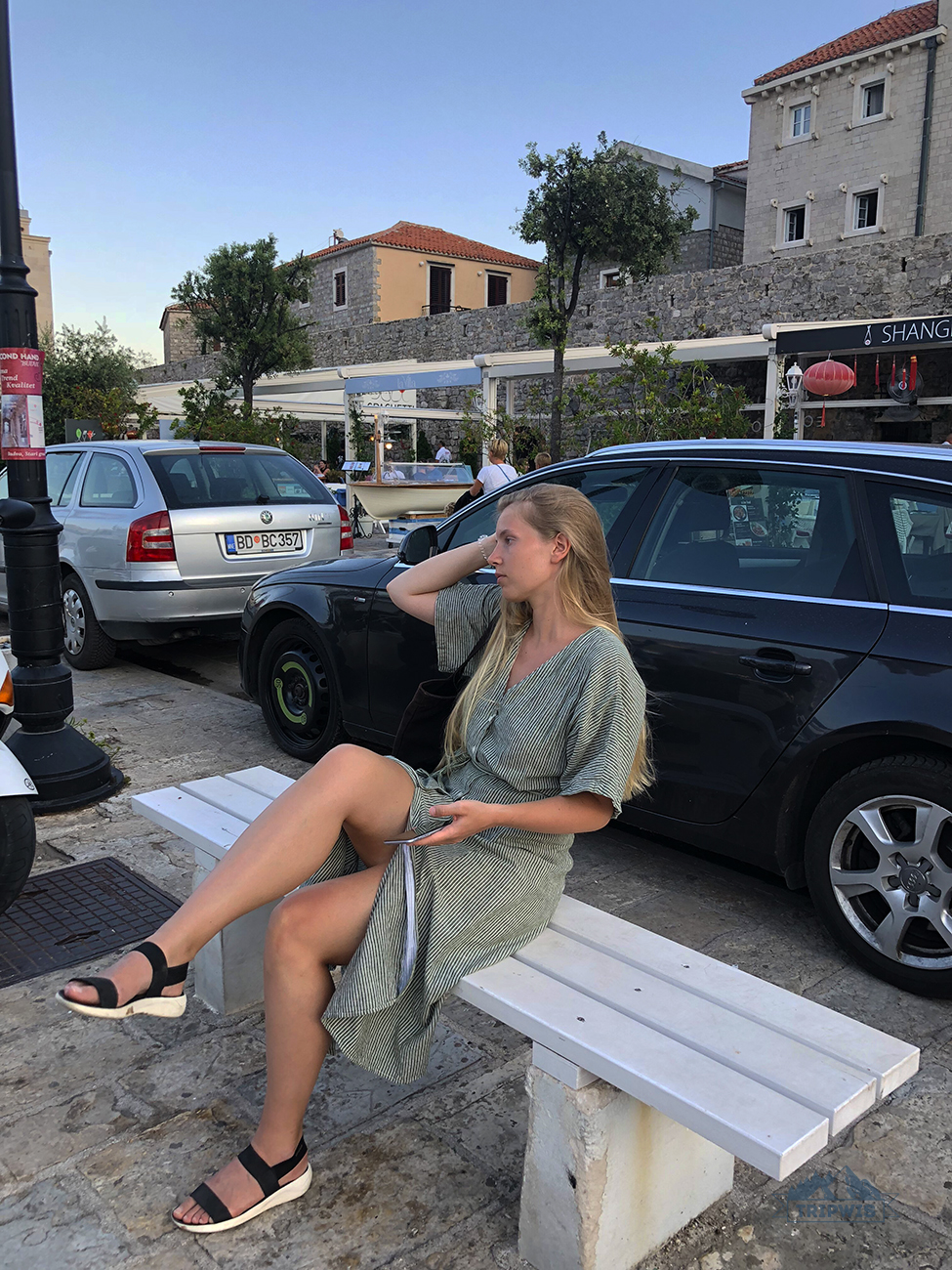 |
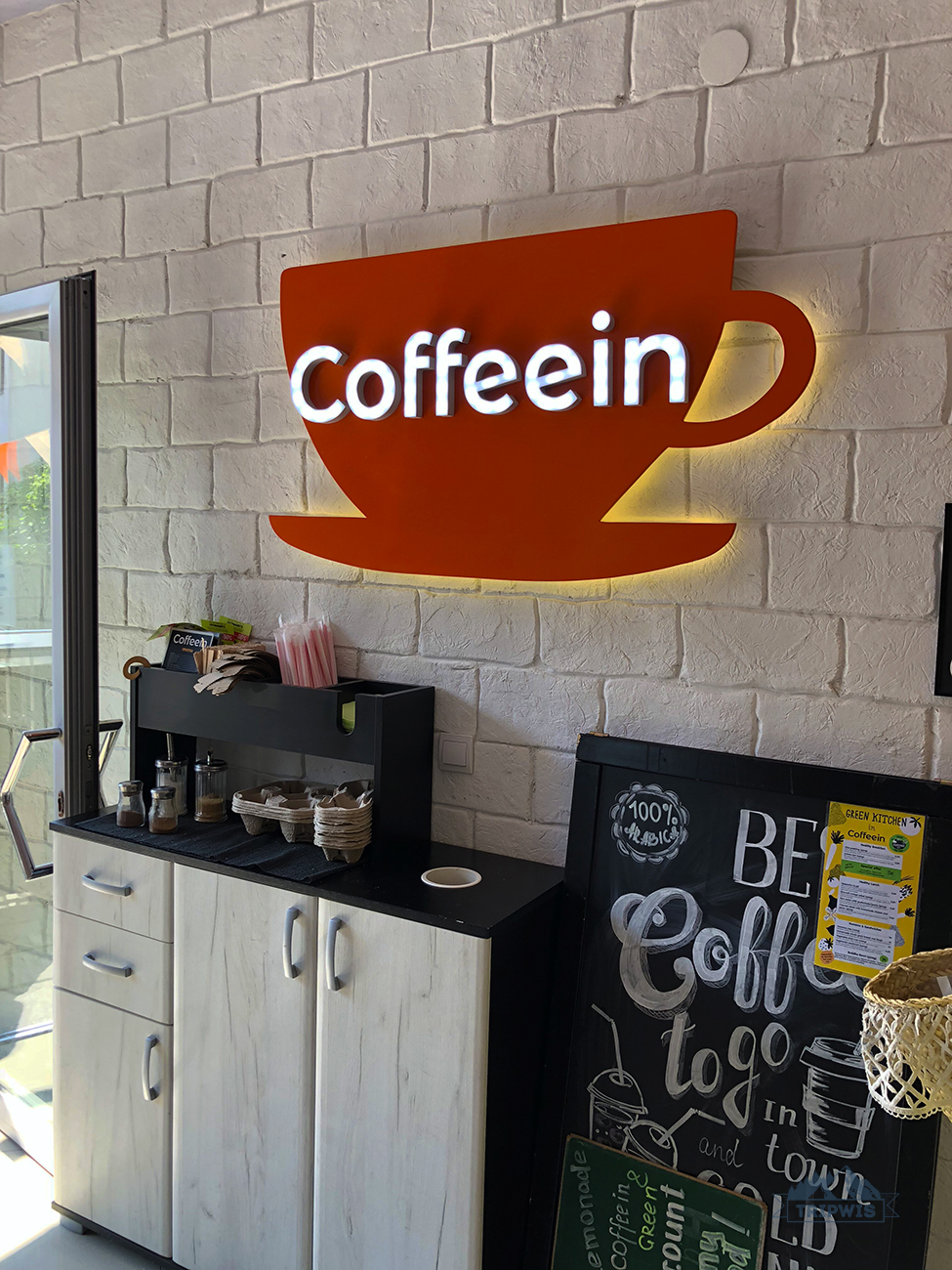 |
Now to the more heartbreaking part: Montenegro is neither a “coffee country” nor a “tea country.” Sadly, it’s a “Nescafe country.”
For most locals, the peak of their coffee experience is literally Nescafe 3-in-1 instant coffee. And I’m not even kidding: In restaurants, even fairly fancy ones, you may see “NESCAFE” on the menu among other drinks.
The situation is not better when it comes to tea. In most places, when you order tea, you’ll get a tea bag, a cup of hot water, and some honey or lemon juice to make your drink.
Luckily, there are plenty of coffee shops owned by Turkish, Russian, or Ukrainian immigrants. These places have a variety of roasts to choose from and make more than decent specialty coffee. Your best bet of finding great coffee is going to either Tivat (there are a few coffee shops here on the fancier side, like Capulus Coffee and Kafeterija Porto) or Budva — the latter is home to Casper Bar, which is an unofficial mecca for local coffee lovers.
Because of the country’s adamance to fully embrace contemporary coffee culture, make sure to have your caffeine intake figured out before you go traveling in Montenegro — you’ll be thanking yourself later!
Where to eat in Montenegro?
 |
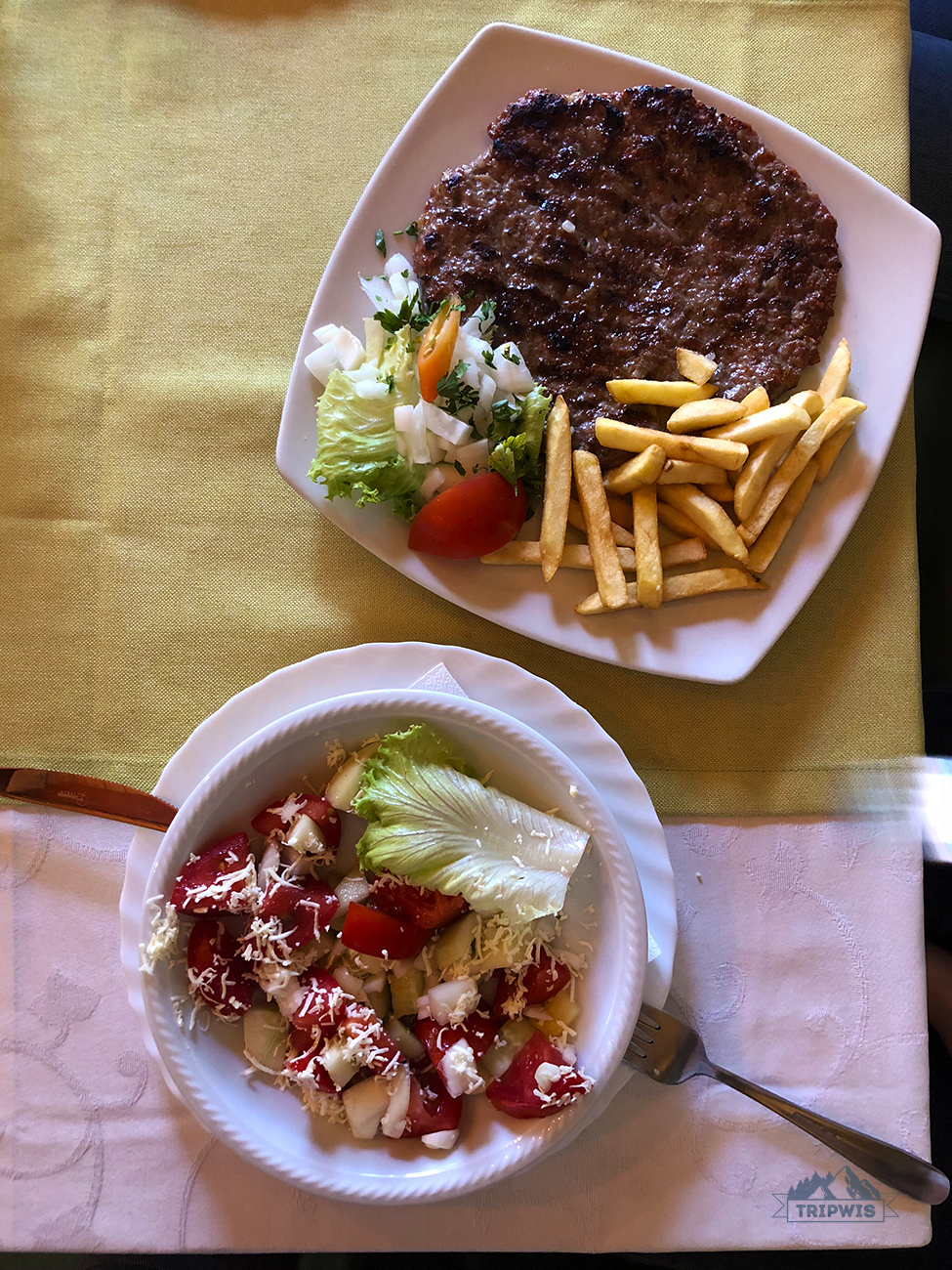 |
Now that you know what to eat in Montenegro, it’s time to get back to the “where” of it all — thankfully, the country has no shortage of both amazing little eateries and also established restaurants. Personally, we favor the more “local” jaunts, for their character and unique flavor choices.
In Montenegro, you can never go wrong with food establishments that’re swarming with locals — that way you know you’re in for a treat, and an affordable one! The list of great places to eat in Montenegro is long, but we decided to narrow it down to our personally tried-and-tested spots:
- Where to eat in Budva?
Kužina — as authentic as it gets, THE place to go for local food. Breakfast, lunch, dinner, — all of your meals can be covered here. The menu is predominantly meat-forward (as expected), and remember our tip about portion sizes! Just take it slow and don’t order too much too fast — chances are, you’ll be full seconds after the first aperitivo!
Grill Basta PARMA — best pljeskavice in town, hands down! There isn’t an English menu here, so you know the food is going to be good! Huge portions, prices on the cheaper side, — what more could you ask for? Note that the service might be a tad slow, since there aren’t enough waiters for the two of the restaurant’s levels, but they usually make up for the wait by offering you a free dessert (a nice, but rare touch).
Casper Bar & Coffee Roastery — best coffee in Budva. Hell, it might be best in all of Montenegro! As we’ve mentioned above, this is a sacred place for both local and visiting coffee afficionados. Come here to get your cuppa in the morning (they even have alternative milk options here), and don’t forget to pop back in at night — their spirits list is impressive, with great cocktails mixed just how you like it!
- Where to eat in Tivat?
Kafeterija Porto — nice coffee with a variety of roasts & specialty options. Best paired with one of their delicious muffins or small tarts! However, the real cherry on top of your Kafeterija Porto experience is the view that opens up from the terrace — shimmering waters of Kotor Bay and hazy mountains in the distance.
- Where to eat in Herceg?
Tri Lipe — amazing little restaurant located not too far from the Herceg Novi Beach. You know that feeling you get after swimming and being in the sun all day? Like you’re so hungry you could eat a whole cow? This is the place to make your hunger go away, potentially forever… JK! But for real though, we know that Montenegro’s meat-based dishes are delicious, but what you don’t know is that their seafood (especially in coastal towns) is also spectacular! Tri Lipe straddles the two sides perfectly — both their meat and seafood dishes will make you want to come back here again and again.
- Other notable mentions
Horizont Bar (Cetinje) — a bucket list experience! Not so much for the food though, but more for the chance to witness a mind-boggling view of Kotor Bay. The place only serves drinks (and the list of overpriced bevs is pretty limited), but you’re guaranteed to still have your head spinning from the stunning panoramas (reminiscent of Switzerland’s most gorgeous passes, just to give you an idea). If you want to catch the sunset from the bar, come a little earlier to secure your spot: Seats fill up fast right as the sun starts to fall behind the mountains.
Zeta Hotel Restaurant (Rafailovići) — nice place with mostly Georgian cuisine and stunning views from the terrace. While the food is not considered local per se, it still goes well with the surroundings, — a romantic dinner is in order!
Pro tip: There’s one phrase you need to learn to be able to save yourself from overeating in a Montenegrin restaurant. If you’re not that hungry, say “pol-tonira” when you order anything potentially big. It means half the plate for half (or almost half) the price. This will save you from overpaying and leaving a good part of your meal untouched once you’re full.
Get off the beaten path
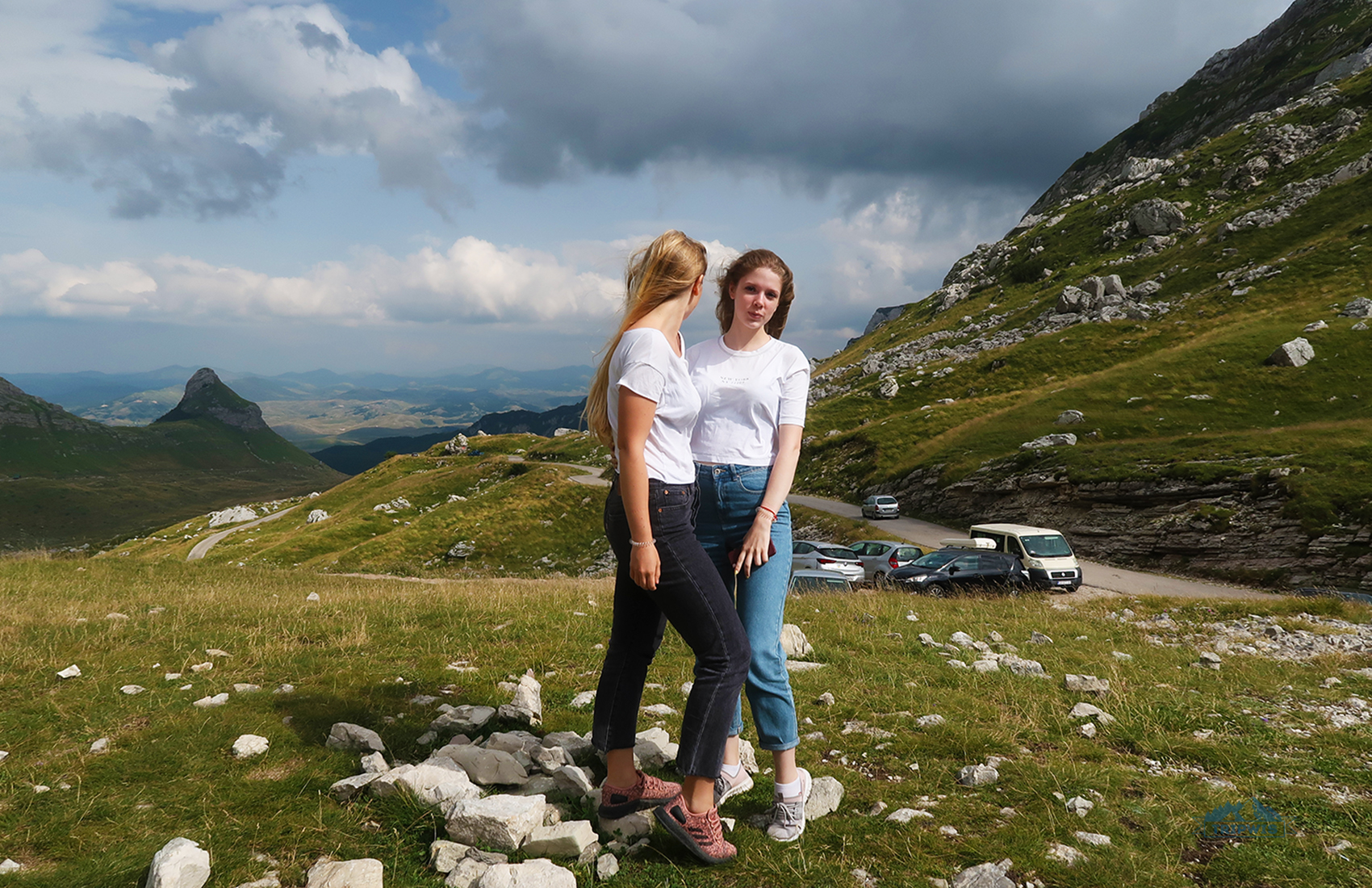
Once you’re properly energized, you might want to start thinking about what to do in Montenegro to at least try to burn off all those calories. A long and scenic walk is in order, but here’s the problem: Montenegro is no longer some “secret destination”. It’s fairly developed, with its own set of crowded hikes.
Plenty of listicles with things to know before visiting Montenegro have only the more popular, “basic” locations to give to their readers. We won’t waste time on them. There are no truly “bad” ones I’d have to warn you about anyway.
Instead, I can say from experience that it’s always a good idea to get off the beaten path. Of all the chances we took with such “less popular” routes, none were disappointing.
Here are a few suggestions:
Instead of Kotor Fortress Route, go for Old Kotor Trail through a window in the wall
 |
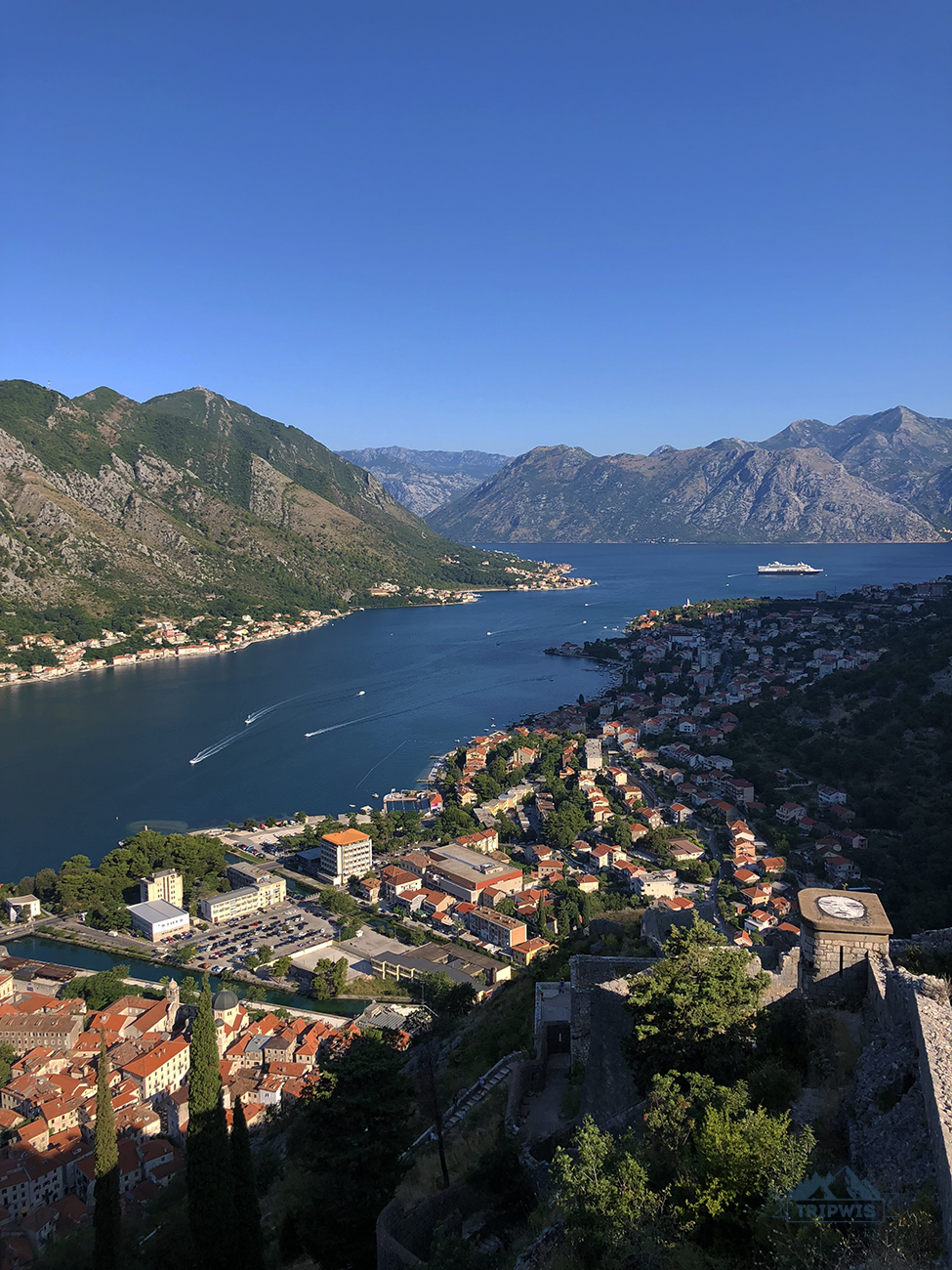 |
It’s not a metaphor! When you start your journey to the top of the Old Kotor Fortress trail (an hour-long hike above Kotor’s old town), you’ll be surrounded by crowds. It’s a paid (€15 per person) and fairly popular route to one of the most popular viewpoints in Montenegro.
We’re not doing popular here. So, in the middle of the road to the fortress, you’ll find a wall (the old fortress wall, you won’t miss it) with windows overlooking a scenic valley. Look down through the window: There’s a pretty good chance there’ll be a ladder.
It’s a trick that some other blogs present as a way to get on the Fortress Trail for free without paying the entrance fee, but it’s way more rewarding and adventurous if you use it the other way around.
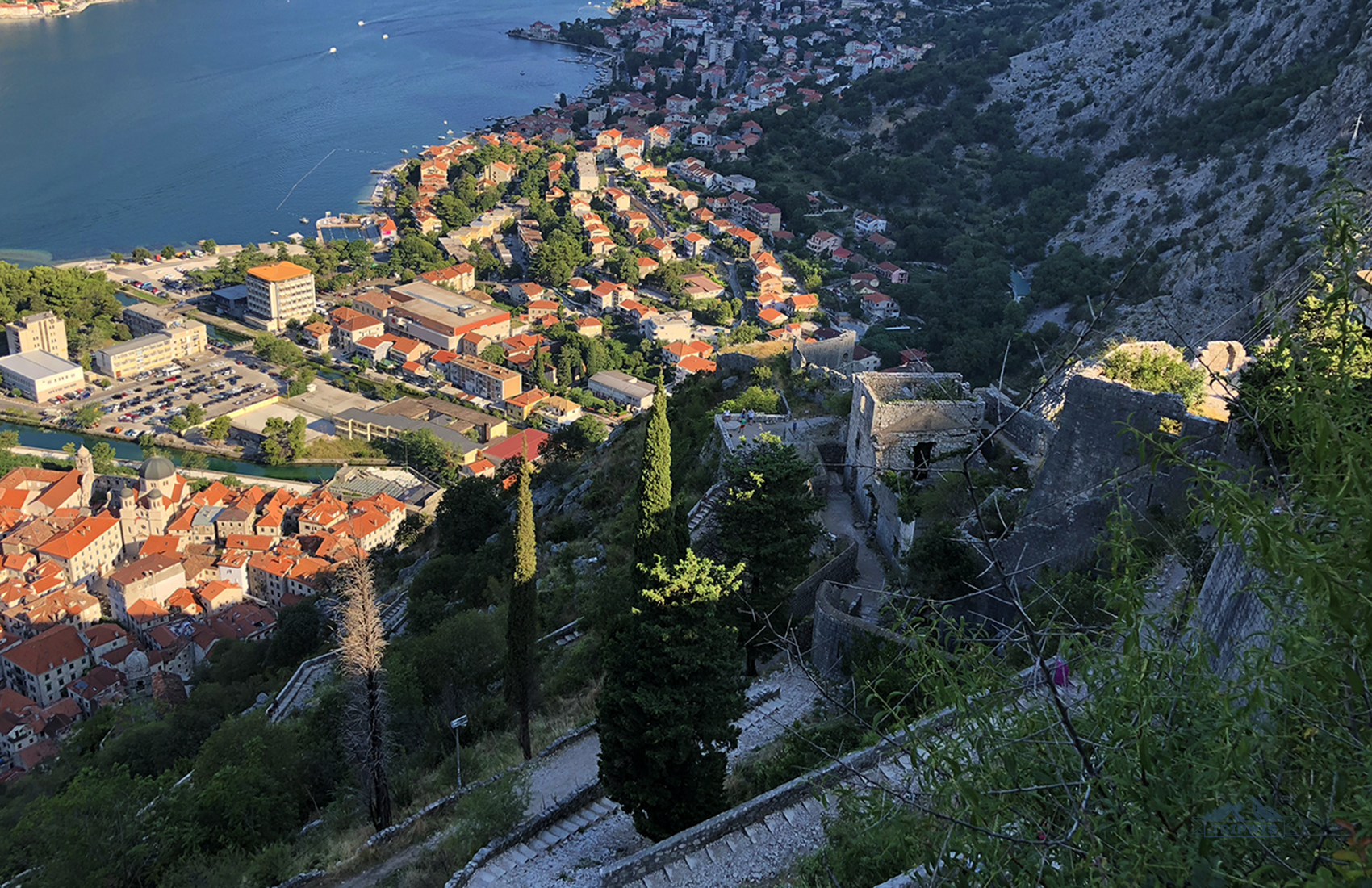
Climb out of the window and follow a small trail in the middle of the valley. It’ll take you to the middle of the Old Kotor Fort Trail, which winds up far higher, with no one else around.
- I have no idea how this trail has ten times fewer reviews on Google than the Old Kotor Fortress one! The view from the fortress is nothing compared to the one from the isolated, windy summit of the Old Kotor Fort Trail.
As a nice extra benefit, you’ll pass a small house of local farmers that sell delicious goat cheese and have a tiny make-shift “cafe” in their backyard. And on your way down, you’ll pass the stunning Skurda canyon with a mountain spring.
In Durmitor, look for the Ćurevac viewpoint, not the Tara Canyon

The Tara River in Durmitor is breathtaking (note that you actually can go white water rafting here; a tip for the daredevils at heart). And the “Tara Canyon Viewpoint” is one way to admire it in all its glory. Not the only way though!
Tara Canyon Viewpoint is a stop in the middle of the road, with a big part of your “trail” being a literal paved road. Passing cars, tour buses that stop here, and crowds during the season all detract from your experience.
Instead, look for Mount Ćurevac. It’s a long hike through the woods that’s somehow less popular than other locations in Durmitor but far superior to most of them.
- First of all, it’s at the edge of the forest, with pine trees hanging above the canyon (instead of being on the side of the road);
- Second, it’s the highest point above the deepest part of the canyon. You can’t get higher than that, and given that the Tara Canyon is officially Europe’s deepest canyon — it’s quite a unique view;
- Finally, it’s not on the list of places to visit in Montenegro for most tourists. You’ll be able to enjoy the mountain air without the dust from the cars (there is a parking lot, but it’s fairly far below) and the noise from the crowds.
Just don’t stop halfway as some people do. There’s a trail that winds up from the parking lot up to the summit, and there’s a small wooden bench up there when you get to the point. The parking lot is not the end of it.
Instead of Sveti Stefan Viewpoint, go to St. Sava Church
Sveti Stefan Viewpoint is positioned right next to a cafe that sells mediocre food and drinks and doesn’t even try to hide the fact that they don’t care. They know that people come for the view, not their food. So why bother?
The saddest part is that the view is also mediocre at best. It overlooks the roofs of Sveti Stefan, but that’s it.
Instead, go to Sveti Sava Church. Once you’re in Stefan, you’ll see it up in the mountains. It’s a hike through the woods and it’s definitely worth it. You need to pass Sveti Stefan and make it just a little beyond the Crvena Glavica turn. You’ll see a mountain road on your left. Go to the end of it and go through the woods towards the church. You won’t miss it, it’s a well-marked trail. Try and catch the sunset from the point — it’s a truly unforgettable experience!
What is the best time to go to Montenegro?
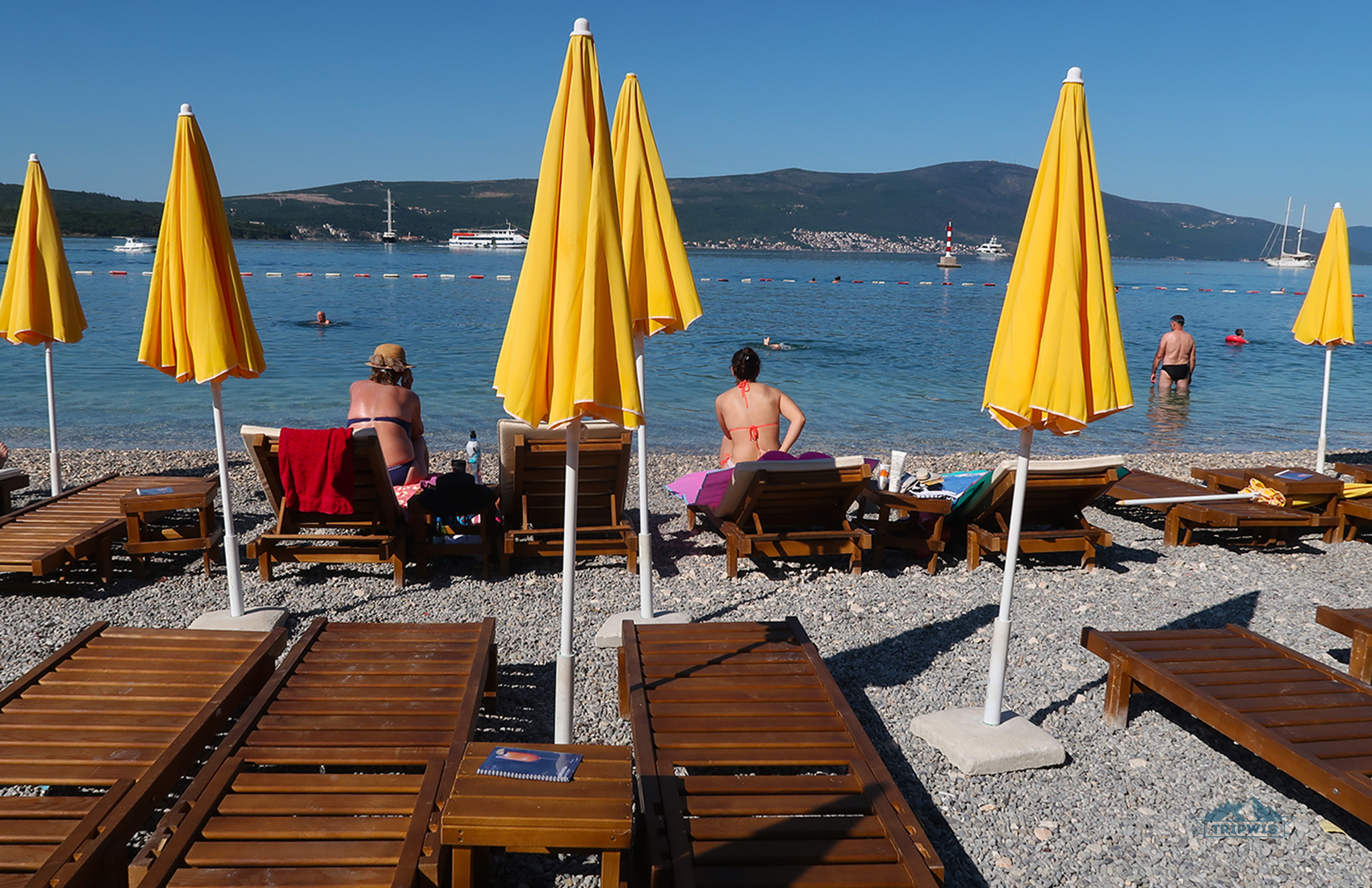
The time you choose to go to Montenegro not just affects but completely defines your experience. If you’re planning your trip to Montenegro early, you have enough room to tweak the dates a little bit.
We’ve seen all seasons here first-hand, and this is what you can expect:
Summer, May to September: High season
Safety and affordability vanish during this season. Montenegro’s tourist industry lives off these few months and takes all it can from them.
Expect prices to be inflated, streets filled with immense crowds during the day, and at nighttime — with loud music from every bar. The beaches, usually free, become full of pay-to-use (€20–€30 per day) sunbeds and umbrellas. Traffic jams are a constant and can be hours long.
Unless you’re a party animal with a passion for never-ending +37°C (about 100°F) scorching heat, it’s not the best time to go. You just won’t see a lot of Montenegro through busy streets and lines at every step of the way. You won’t taste it either, because most restaurants during this period put speed way over quality.
Pro tip: Most of the holidaymakers crave a classic beach holiday during the summer. However, don’t expect postcard-worthy golden sands here: Practically all beaches in Montenegro, except maybe for a few near the Albanian border, are rocky. And if you happen to come during high season, don’t expect to find a free spot after about 9 a.m. Most places are THAT busy.
November to February: Low season
Now, this period is the exact opposite of the one above. Most tourist-oriented coastal locations (say, Perast) turn into little ghost towns. There are practically no people around and no open places, except for a couple of cafes that cater to locals.
It’s not a real winter in a classic sense: It’s not cold, and the temperature almost never falls below zero. It’s +5°C…+10°C (32°F…50°F) most of the time, with frequent heavy rains.
The weather during the winter makes hiking difficult, roads — slippery, and street cafes — just not an option. Museums and monasteries often plan renovations for the winter as well. Life is OK in bigger towns, but if you don’t really enjoy complete solitude, it’s not the best time to go.
Late March and October: Shoulder season
What is the best month to visit Montenegro? There isn’t one per se, but we’re pretty sure March and October get a tie in this competition. Without a doubt, this is the absolute best time to go to Montenegro:
- The sea is warm enough to swim comfortably, but the beaches are not crowded;
- Restaurants are mostly open, but not packed. If we’re talking about March and April, they’re most likely trying out their new menus, focusing more on the quality of food rather than serving a hundred guests in one hour;
- The prices have no “peak season effect” either. Everything costs what it normally does.
It’s also the best time to visit the northern part of the country, the Durmitor National Park: It’s neither hot nor a complete Winter Wonderland yet.
Choose the right part of the country
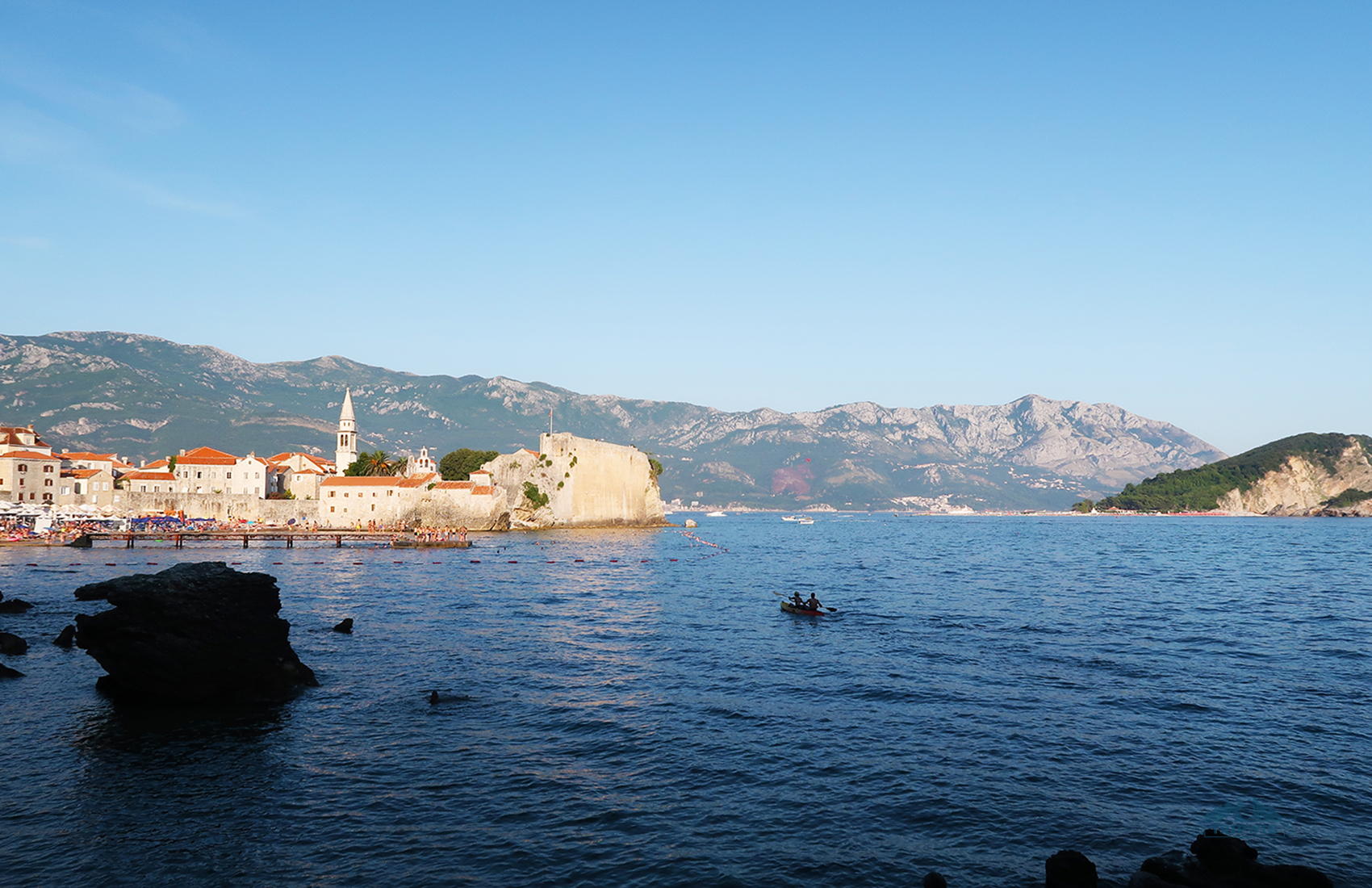
If we oversimplify the geography of Montenegro, you have three major regions to choose from:
- The North — Durmitor National Park, insane mountain ranges, crystal-clear lakes and serpentine roads, a nature lover’s paradise;
- The Valley in the Middle — Podgorica (often dubbed Europe’s most boring capital for a reason), Nikšić (a smaller, mostly boring and commercial city as well), and all the surrounding areas fall here. This part of the country is not really popular among tourists;
- The Coast, from Bar Riviera to Kotor Bay, including Budva — the whole coastline goes here. It’s the liveliest, most tourist-friendly, and, in my personal opinion, most visit-worthy part of the country. It also includes Lovcen National Park (which is covered in this amazing day tour option).
Don’t get me wrong, it’s a really, really rough way to put it. Around Podgorica, you have a stunning saltwater lake with flamingos and the ancient Ostrog Monastery (a great day trip will take you here, after letting you explore the Tara canyon and Durmitor Mountain). The bay area isn’t all fun and games either: There are nearly empty (attractions-wise) small local villages here, like Strp. It’s not so simple, but it gives you a bigger picture.
Pro tip: Don’t get TOO picky with your accommodation. Iconic locations are scattered all across the country with small distances between them. Transportation plays a much more important role: Focus on bus stations and public parking nearby rather than on your hotel’s proximity to the nearest beach.
Best places to stay in Montenegro

Where to stay in Montenegro is a very important question to look into before coming here. Your plane will arrive at one of the country’s two airports: Tivat or Podgorica. Tivat is, in fact, an ex-airbase: It’s smaller but closer to the sea. Podgorica Airport is a busier place, but it’s quite far from all the truly visit-worthy locations.
Montenegro is multidimensional, as are its main areas. Thankfully, we have first-hand experience of visiting all of them, with enough intel to share with you:
Podgorica — The Capital — is not quite what you need
Some say it’s the most boring capital in Europe. Some say that it’s OK. Nobody ever said that it’s the best the country can offer.
There are residential districts, some relatively small shopping malls, lots of restaurants and cafes, a couple of nice landmarks (like the Cathedral of Christ’s Resurrection and the park around Millennium Bridge), and… that’s it.
Podgorica is more of a commercial and business capital of the country, not the crown jewel in Montenegro’s collection of cities. It’s an ordinary city life experience in the middle of an extraordinary country, not quite what Montenegro is best known for (same sentiment can be attributed to Nikšić).
Podgorica is a 1.5-hour ride from the coast, — great location if you suddenly need to buy something they don’t have on the coast, but not a good place to stay in overall.
Pro tip: Tivat Airport has a notoriously short airstrip. Sometimes, when the weather is bad, planes are redirected to land in Podgorica. It’s not a reason to worry: The airline should organize free transfer, and even if it somehow doesn’t — there are plenty of buses from Podgorica to the coast, €8 for a one-way ride. Or, if a bus ride on the curvy mountain road is your definite no-no, book a transfer on Gettransfer.com.
Recommended hotels in Podgorica:
- 3* Kerber Hotel (from €50 per night)
- 4* Hotel Podgorica (from €80 a night)
- 5* Hilton Podgorica Crna Gora (from €120 per night)
Budva — the Tourist Capital — is a good option
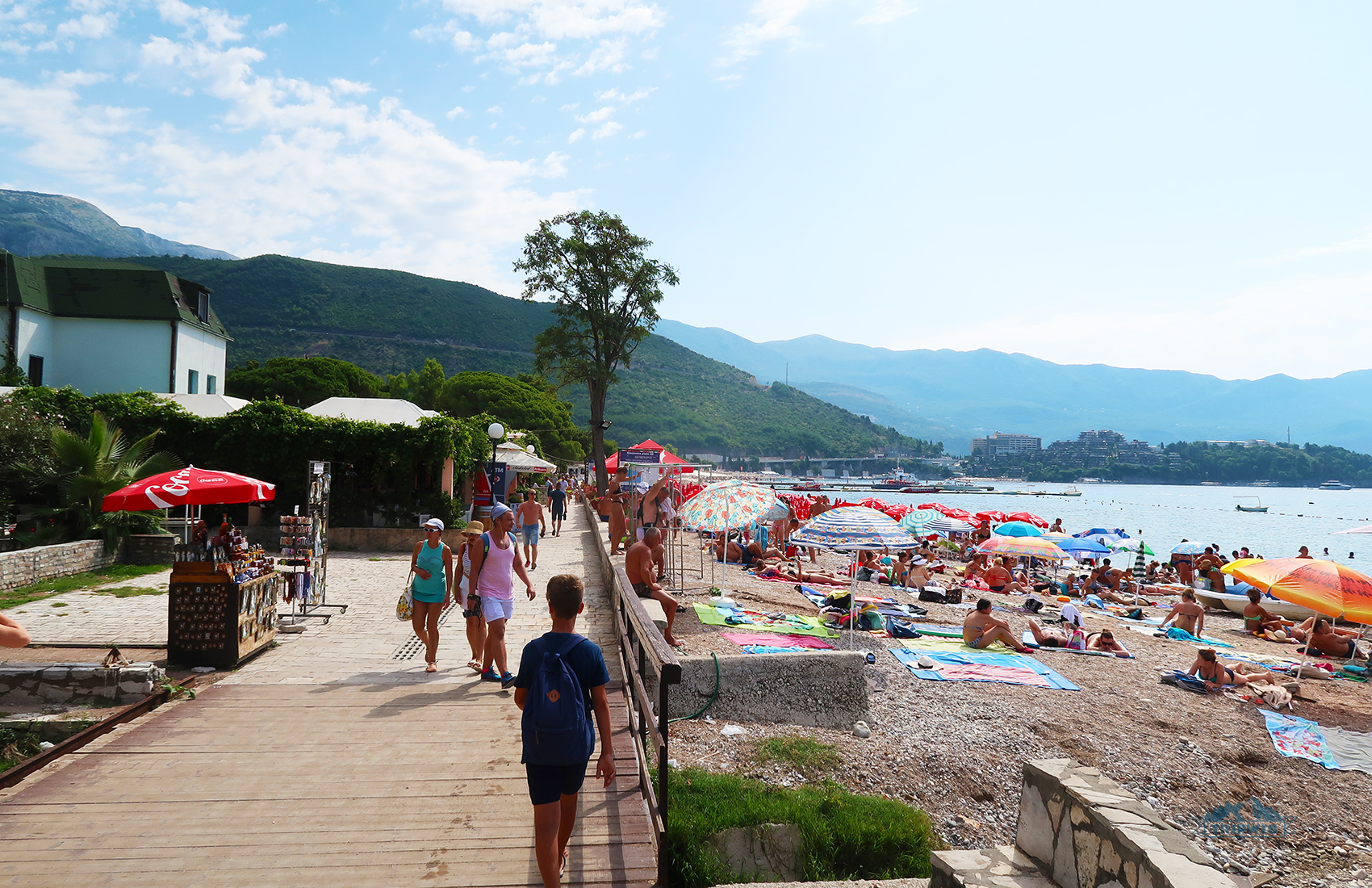
Budva is one of the biggest cities by the sea in Montenegro. Unofficially, it is the biggest one. It’s positioned facing the Sveti Nikola Island, in its own small lagoon, so even during storms, the sea is not that rough here.
It’s set pretty much in the middle of the coastline, with Kotor Bay located within a 30-minute drive and anything else along the coast within an hour or two. Budva has both calm areas (further away from the sea) and more lively locations (around the Plaza Mall, the Old Town). It has it all — and we covered it in our special guide to Budva.
Budva is the best option for where to stay in Montenegro in almost every way, but it might be a bit more expensive than others, — there are so many five-star resorts lining the coast you would think you’re in the Maldives!
Recommended hotels in Budva:
- 3* Hotel Hermes (from €70 per night)
- 4* Iberostar Bellevue (from €75 per night)
- 5* Splendid Conference & Spa Resort (from €120 a night)
Budva Riviera — the Scenic Coastline — is eclectic
We can’t talk about Budva without mentioning that it seamlessly connects to a whole lot of other locations. Most of the online sources somehow position these towns as completely different locations, but it’s not true.
If you’re searching for where to stay on the Riviera and are seriously choosing between, say, Przno and Rafailovići — don’t bother. They’re not that different. Wherever you stay around Budva, you’ll almost always go to Budva itself for anything other than basic groceries. All services, stores and events are in Budva.
Here’s a quick breakdown of what the area has to offer:
- Bečići
Positioned right next to Budva, it’s mostly bland concrete 5-story buildings with a long and broad beach across the highway. There’ll either be a road or a resort between your hotel and the sea. Bečići is considered to be a cheaper side of Budva, even though it’s a whole separate town. A 15-minute walk (or a 3-minute ride) is all it takes to get here from Budva.
🏨 4* Hotel Svarog (from €45 a night)
- Rafailovići
A fancier district that Bečići seamlessly flows into. Lots of cafes and stores, but almost no way to get here by car (the road goes up through the mountains, with Rafailovići set practically at their base).
🏨 4* Ponta (from €70 a night)
- Kamenovo
It’s literally just a beach and a few makeshift buildings, with a residential district set by the road up on the mountain. You can get to Kamenovo beach through a tunnel from Rafailovići. It’s crowded during high season (for some reason, it’s exceptionally popular among tourists from Serbia) and is empty for the rest of the year.
- Pržno
It’s a beautiful old fishing village, with the waves almost knocking on some houses’ doors. Pržno has a small beach, a supermarket (the only one in the area; all the other big stores are in Budva, and we’re about 20 minutes of driving from it already), and 5-6 restaurants. That’s it. It’s so tiny, you can walk around the whole village in 40 minutes or less.
Pržno is a good place to stay if you don’t plan on traveling around the coast a lot: It’s picturesque, cozy, relatively cheap, and has a massive park with century-old olive trees right next to it.
- Sveti Stefan
You get to Sveti Stefan from Rafailovići through the aforementioned park via King’s Beach (the old residence of the Montenegrin royal family) and Queen’s Beach (their second residence). Both are essentially small, charming lagoons with royal mansions and cypress groves. And both — sadly — are leased to a private hotel chain. It means security at every corner and no chance to just chill in picturesque groves.
Same goes for Sveti Stefan itself: The iconic tiny village on the island, the one you may have stumbled upon on Pinterest. It was converted into a hotel complex long ago, and now it’s closed most of the time, with public access cut off right at the end of the bridge.
The beaches along that bridge are private, too: During peak tourist season, it may cost up to €50 per day to enter. Just a couple of small plots are open to the public.
The rest of Sveti Stefan, while it offers stunning views, is rather small: The town literally has five cafes, two small stores, and that’s it. Also, since it’s positioned on a mountain slope, you will — most likely — use stairs a lot, with no ability to park your car next to your accommodation.
Pro tip: If you really want to get a glimpse of Sveti Stefan from the inside, do a bit of research and plan your visit for some major orthodox holiday. There’s a church on that island that locals are allowed to visit on holidays. It’s the only way to get in without waiting for the hotel to open and paying crazy prices to stay there.
🏨 4* Harmonia Bungalows & Pool (from €80 a night)
Tivat — the Luxury of Porto Montenegro — is elusive
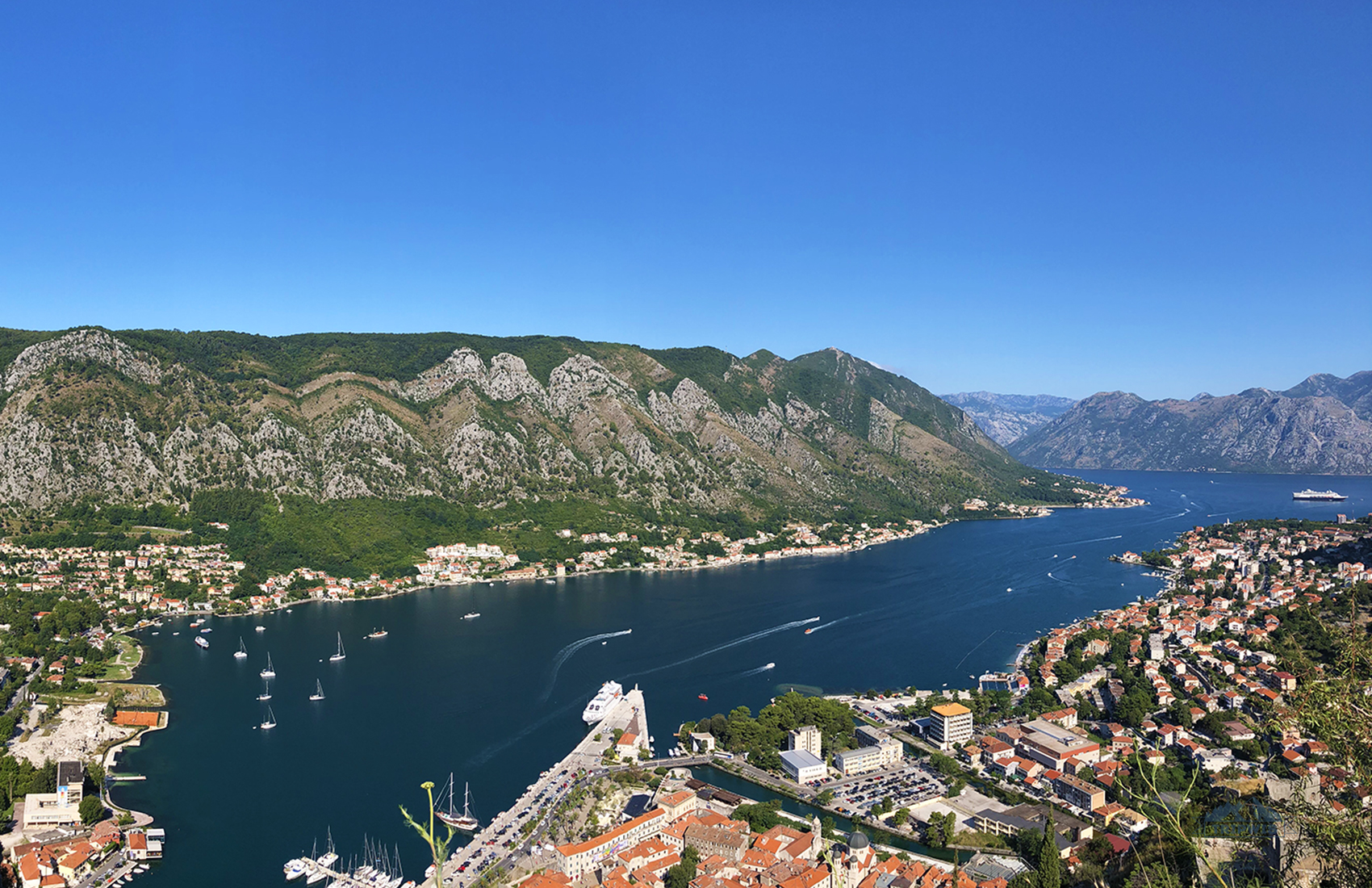
Now, we move from Budva straight to Kotor Bay.
Porto Montenegro, the marina that many compare to Monaco, is stunning. Mega yachts, Dior and Rolex boutiques, fancy cafes and awesome views, — this part of Tivat is, indeed, luxurious.
Too bad it’s just a few buildings and a short stretch of the coast, with the rest of Tivat being rather boring and residential.
Porto Montenegro might be on every flyer, drone shot, and list of things to know before visiting Montenegro, but keep in mind that it’s really small. One or two hours is more than enough to explore it fully.
The proximity to Tivat Airport (a 10-minute ride) would make it a good location transport-wise, but there’s no regular bus or shuttle between Tivat and its airport (taxi or walking are the only options). The bus station is a 20-minute walk along the highway from the city, not the best option if you don’t have a car.
Recommended hotels in Tivat:
- 4* Hotel Pine (from €75 a night)
- 5* Regent Porto Montenegro (from €250 a night)
Kotor and Dobrota — the Ones From All the Postcards — are great
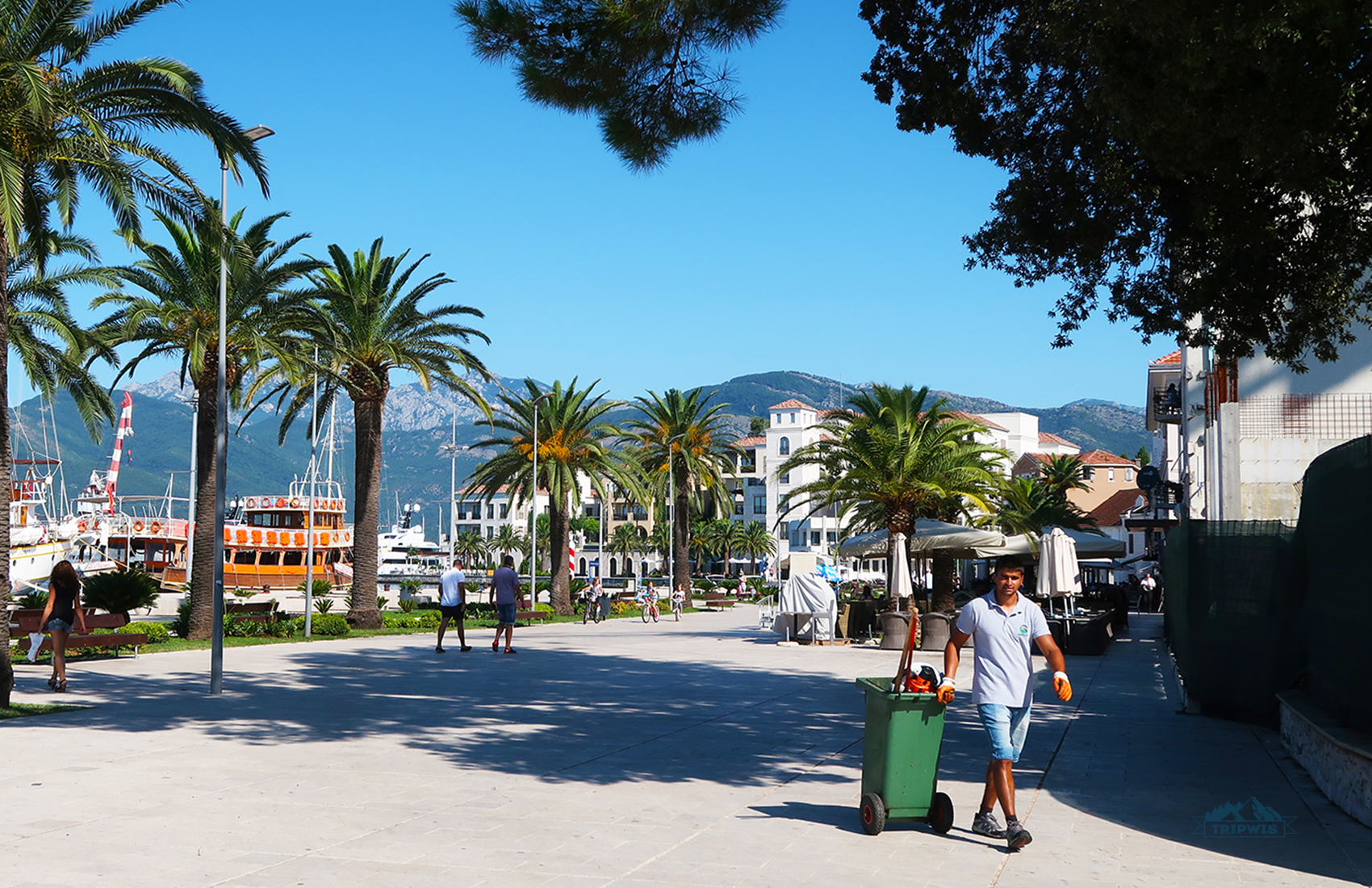
The grand Kotor stands at the point where two massive mountain ranges come together, with the bay at the bottom of the canyon. This stunning city is famous for its massive old town, ancient fortress up in the slopes, and all the cruise ships.
Transportation-wise, Kotor is separated from the main highway by mountains, but it takes just 10 minutes to get here through a tunnel. The bus station is right in the middle of the town, so it’s a convenient place to stay if you plan to travel a lot along the coast (which you probably should).
The Stari Grad (Old Town) here is truly old: It’s an authentic medieval village, one of the best-preserved ones of its kind on the Adriatic. It’s filled to the brim with big and small unique locations, from Kotor Cats Museum to cafes and restaurants of all kinds. There’s a great walking tour of the Old Town for visitors who would like to learn the history behind the gorgeous buildings of the area.
If you get tired of ancient stone walls, you can walk down to the Dobrota embankment, where there are all kinds of things to do, from sunbathing and SUP boarding to just chilling on one of the numerous street terraces.
Pro tip: If you’re in Kotor’s Old Town and you hear the horn of a cruise ship, you might want to find a place to sit and chill somewhere inside for a few hours. The sound means that in a matter of minutes, the ship will “park”, and the streets will completely change, with a massive crowd of passengers flowing in.
Alternatively, you can do a little Uno reverse and go on a boat tour yourself, — that way, the crowds will be on land while you’re exploring the waters of the bay!
Recommended hotels in Kotor:
- 3* Hotel Rendez Vous (from €60 a night)
- 4* Hotel Vardar (from €120 a night)
- 5* Hyatt Regency Kotor Bay Resort (from €150 a night)
Herceg Novi — the City of Flowers — is more about stairs
Herceg Novi is probably one of the most colorful cities along the coast. It’s clean and well-maintained, with dozens of churches and museums, scenic views, and… stairs.
Don’t underestimate the number of stairs here: Wherever you go, you’ll either go up or down, never straight. Yes, even if you walk parallel to the coast. Yes, even inside (!) most cafes and churches, there are at least a few steps.
Logistics-wise, it’s tolerable but not quite the best option to choose for your base in Montenegro. The bus station is rather far from the center (and, you’ve guessed it, you have to climb some stairs to get here). Parking is a nightmare (you get one massive and poorly maintained parking lot by the beach and one by the road up the hill). It’s rather hard to drive here if you lack experience in navigating one-lane winding roads.
In short, I’d say that Herceg Novi is definitely worth visiting, but it’s not quite the best option to stay here if you plan on leaving the town often.
Recommended hotels in Herceg Novi:
- 3* Garni Hotel Bokeška Noć (from €55 per night)
- 4* Palmon Bay Hotel & Spa (from €85 a night)
- 5* Lazure Hotel & Marina (from €150 a night)
Bar — the Budget Option — is cheaper but further away from everything
With the Bay Area covered, we’ve got to talk about the cities in the far east of the country.
Bar (called so because it’s right across the sea from the Italian town of Bari) is closer to the country’s eastern border but far from the Bay area. It’s a more popular place for people who come to live here, but less so among tourists.
On the positive side, you get nicer beaches (longer, broader, some even with sand instead of rocks), more tame prices on pretty much everything, and a nice, small Old Town.
The main drawback is location, though: Not that much of a problem if you rent a car (just factor in an extra 30 minutes or so), but a lot more complicated if you plan on traveling by bus.
Recommended hotels in Bar:
- 4* Hotel Princess (from €80 a night)
- 4.7* Stara Čaršija Hotel & SPA (from €120 a night)
Ulcinj — the Little Istanbul — is on the far eastern side of the coast
Montenegro had a lot of battles in its history. Most of them were with the Ottoman Empire that constantly tried to colonize the Balkan land. At some point, the eastern part of what’s now Montenegro decided that it couldn’t fight anymore and accepted the Ottoman rule. For years, a big part of the population was under Turkey’s de facto control.
That’s why we have a Little Istanbul here, in an otherwise Christian and even Orthodox country.
Expect to see a lot of shops and small boutiques, hear a lot of mosques, and see a local variation of a classic Turkish bazaar. It’s a totally different vibe from everything else. As a side benefit — Ulcinj has probably the best beaches in Montenegro.
Unfortunately, it’s almost on the border with Albania, which makes it really distant from everything else, except maybe for Lake Skadar (don’t forget to get a boat tour on the lake if you’re ever in the area). It’s not an optimal place to stay, but it’s definitely worth a visit — just to get a taste of local contrasts.
Recommended hotels in Ulcinj:
- 3* Hotel Ajana (from €50 a night)
- 4* Apart-Hotel President (from €75 per night)
- 4* Azul Beach Resort Montenegro (from €140 a night)
Žabljak — Mountain Village — is a cabin-in-the-woods experience
Finally, Žabljak is a whole different story. It’s located in the northern part of the country, almost on the border with Serbia, within a 5-hour long road trip from the coast.
It’s right in the middle of Durmitor National Park: Think mountain lakes, old-growth forests, and insane views. It’s a perfect place for those who love hiking, but it would be plain boring for anyone who likes to socialize a lot.
Essentially, Žabljak is a typical mountain village: You get one supermarket, a couple of restaurants, a small ranch, and that’s it. The rest is pure nature, with dozens of well-maintained trails.
It’s a perfect way to get away from civilization, but it requires a whole different setup (and probably — its own trip, not the best option if it’s your first time in Montenegro).
Recommended hotels in Žabljak:
- 3* Hotel Pavlović (from €60 per night)
- 4* Hotel Soa (from €75 per night)
How many days is enough for Montenegro?

I hope that with the list above, you now see why the classic dilemma of how many days is enough to visit Montenegro has no real answer. The closest one is probably “all of them”.
Realistically, you’d need at least two weeks to see SOME part of the country (at a true local’s pace). Just a personal opinion here:
- A weekend — one town, doesn’t even count as a real trip;
- 3–4 days — not really enough to explore bigger locations (say, Kotor, Budva, Herceg Novi), but might be enough for a nice retreat in Žabljak with 1–2 hikes;
- 7 days, one full week — enough for a surface-level exploration of 1–2 towns;
- 2 weeks — enough to SEE (not fully enjoy, though) either the coast and the Bay Area or the Durmitor National Park;
- 3 weeks to a month — much closer to a nice, relaxing deep dive into all the options Montenegro has to offer.
Sure, we all have our pace, and some feel comfortable on a tight schedule. My duty here is just to warn you that it kind of goes against the country’s vibe. But if you have no other options — you, at least, need to be really practical with your transportation.
You may want to rent a car in Montenegro (it’s rather cheap anyways)
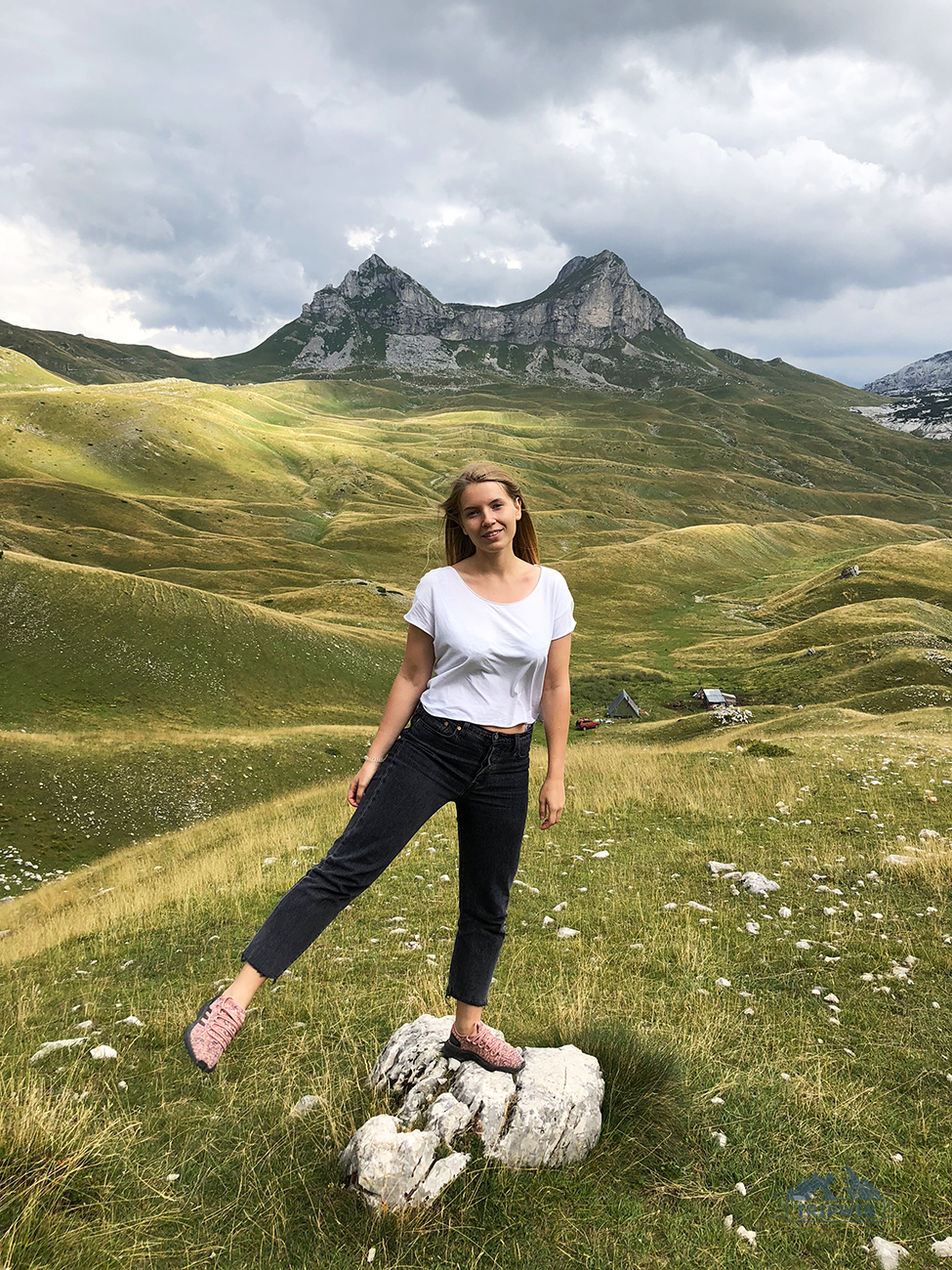 |
 |
You might’ve noticed how much I’m talking about distances here, and it’s not a coincidence. You really need a car to get around in Montenegro.
Our friends at LocalRent make the whole process of renting a car in Montenegro a breeze — if you take away one thing from this whole section, let it be this service. Personally tried-and-tested, it is the thing we feel 100% comfortable recommending.
It’s still possible to see more than two or three locations in Montenegro if you don’t have a license, but it adds a whole lot of hassle to your experience. Just to name a few reasons:
- Local public transport in Montenegro is… not quite reliable
If you choose to travel by bus, you will spend a lot of time finding the nearest bus station, waiting for the bus (which might come 10 minutes early or half an hour late), and walking from the bus station to the nearest place of interest.
It’s not THAT bad, totally tolerable, but it’s not quite as convenient as just driving along the coast.
- Some of the best views are only accessible by car
There is no bus that would take you to Ostrog Monastery. It’s an hour-long drive in a car on quite a steep serpentine road. I can’t imagine anyone walking this distance without being completely exhausted at the top.
The same goes, for example, for Vista Point, one of the highest panoramic spots around the bay. Without a car, it would be a four-hour walk, and there is no public transport to take you there.
- Taxi is overpriced
There’s no Uber in Montenegro, so you have to rely on small local companies. They take orders through messengers like What’s App and Viber, and it’s expected that you book your ride in advance.
Your experience is unpredictable and depends on the driver. Some will be nice and polite, some will take the longest route to keep the taxi meter rolling, and some will just arrive late (often using traffic as an excuse, even if the roads are empty). It’s also expensive as hell, expect to pay €30+ for a short ride.
- You miss a great experience
If you have a driver’s license and choose to rely on public transportation here, you miss out on a fascinating driving experience.
The roads in Montenegro are well-maintained, with practically no potholes. I now know each of the rare few, and every single “notable” one is up in the mountains. The views you get from driving on the winding roads are insane, and there are plenty of spots to park and enjoy the nature around.
The way these roads twist and turn or go down in a perfectly straight line from a steep slope is heaven for those who genuinely enjoy driving (especially if you rent a great car that adds to the overall experience).
Pro tip: How to get around in Montenegro if you don’t have a driver’s license but also aren’t a fan of public transport and not at all reliable taxi services of the country? Look into private transfers through the services of GetTransfer. Get on the hype train of personal transfers: It’s a way to ride in a comfortable BMW, Mercedes, or a fairly fresh minivan instead of a beaten-up, 20-year-old Renault wagon that local taxi companies use. And it usually costs just a little more than a taxi would.
Planning your budget for the trip to Montenegro

While the views are free, you’re still going to spend some money here.
Obviously, we have to acknowledge that everyone has different needs. Some are picky with their wine’s month of harvest, and some are happy with a pint of beer (€3 for a basic local Nikšićko, up to €10 for craft stuff) at any local bar. I’ll focus on aspects that apply to all:
Money in Montenegro
It’s a good idea to exchange your cash to euros before arriving in Montenegro. It’s easier to find a decent “exchange guy” on Facebook than at an official Currency Exchange place. As a bonus, those private (not quite official, though) guys can help you cash out any cryptocurrencies with a fairly small fee.
Every tobacco shop, cafe or museum in Montenegro accepts credit cards. In fact, “cash or kartica”, aka cash or card, is what you’ll hear in 90% of places.
Having some cash in Montenegro is a good idea for buses, taxi rides, and cafe tips (the usual minimum of 10% is OK, rarely included in the check), but it’s not that critical.
How much will you spend — real prices in Montenegro in 2025
I won’t give you any estimates on how much is enough for, say, a week or two. It depends.
Instead, I’ll just open my good-ol’ “Expenses” spreadsheet and give you a glimpse into the real-life data from over a year of tracking our budget here:
- Coffee shops — €3–€5 for a big to-go cup, about €5 for desserts. We’re talking both specialty coffee at fancier places and basic lattes at any run-of-the-mill cafe;
- Groceries — €20–€30 per day for two (if you plan on cooking at home);
- Museums, cinema, all sorts of entertainment — €20–€30 for two. Most small theaters and galleries rely on donations: €10–€20 per person is considered OK. Some museums charge €4–€5 for a ticket;
- Car rent — around €35 per day during the winter for some basic Renault Captur or Hyundai i30, up to €50 during peak season. More solid options like hybrid C-HR and Toyota RAV4 are €50–€60 per day. There are some small and independent car rentals here, but they’re all listed on localrent.com, so no need to search for them yourself;
- Gas — €30–€55 for a full tank, though the prices are constantly rising, and it totally depends on the car and your driving style;
- A decent dinner (main course, salad, drinks) for two — €20–€25 in a mom-and-pop basic place, around €35 in a fancier restaurant, €60–€80 in a really nice place;
- Snacks — pizza is €3–€3,5 per slice (a huge one!), basic gyros are €5–€6, croissants are €2,5–€3 for one;
- Buses — €4–€8 for a two-way ride, depending on the destination;
- Taxi — Airport to Budva (about 30 minutes) — €35, Budva to Risan (the Kotor bay area) — €70, within the town — €10–€12, from Budva to Sveti Stefan — €30.
Pro tip: When in Montenegro, be mindful when using ATMs. Withdrawal fees and the conversion rate might be insane. Double-check and never accept any terms blindly. Erste Bank is probably the least risky option, with fixed fees they’ll warn you about.
What are the do’s and don’ts in Montenegro?
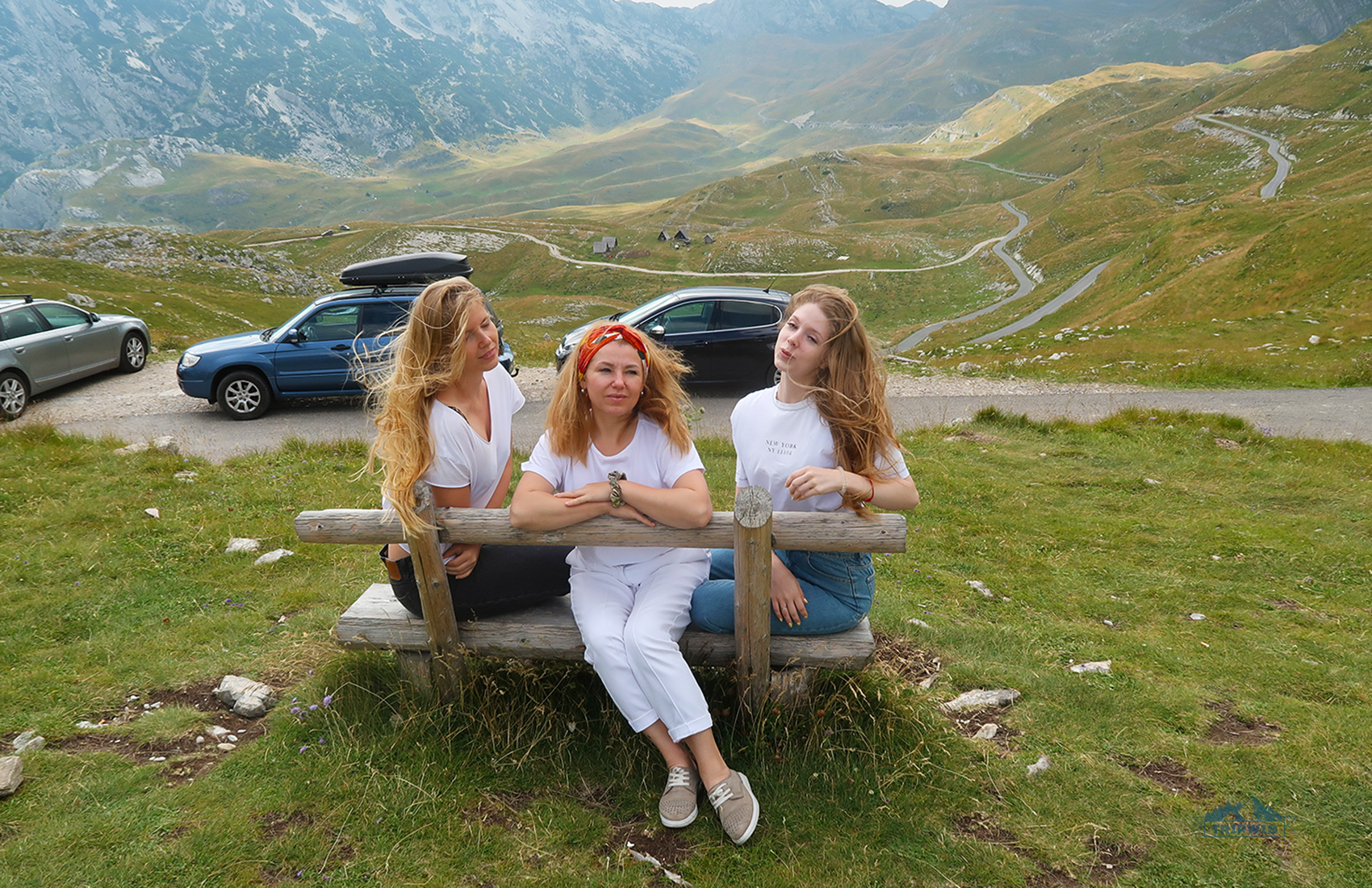
While listing all the things to know before going to Montenegro we’re aware of, we’ve got to leave some room for your personal experience. Maybe you’ll be lucky enough to get all the nicest taxi drivers, and maybe you won’t like the views from Mount Ćurevac. However, you are extremely likely to encounter the same issues as many (us included) did before you.
So, if you want to be smart about it and wonder what the do’s and don’ts in Montenegro are, I’ve got plenty for you:
The Do’s of Montenegro
These are the things most other Montenegro travel tips lists skip in favor of yet another scenic viewpoint or a hotel ad.
We will, instead, get down to the details:
- Do go to a Tourist Information Office ASAP as you arrive
Or at least within 24 hours after entering the country. Otherwise, you’ll have to pay about €200 in fines when you leave. Ask your host (rental property owner, hotel staff) about the details; they must provide you with all the necessary info. Tourist Registration costs €1 per day for everyone, all paid in advance for your whole trip. And don’t throw the pink “receipt” away; you may need to show it at the border when you leave the country;
- Do prepare for the apparent language barrier
Everyone speaks English in Montenegro’s touristy areas, at least to some degree. In remote areas, you’ll have to use Google Translate. Choose Serbian or Croatian (since Montenegrin is not in Google Translate yet);
- Do get your clothes, medication, and gear elsewhere and beforehand
You can buy some basic things here but you won’t find anything niche. For example, if you use contact lenses, you will, most likely, have to order them at some local pharmacy and wait for ten days for them to arrive. You can’t buy camera lenses as well if you suddenly need anything particular. Decent hiking gear & tracking boots, sports gear, and electronics — all quite hard to get here. It’s best to bring your own;
- Do get the MTel prepaid tourist SIM card, not One (MTel works better)
It’s the easiest way to get decent access to the internet in Montenegro. You can get a 1TB plan for €20 in almost every store: It’s official, costs the same everywhere, with no sketchy resellers or store markups (as you’d get in, for example, Istanbul);
- Do ask your host whether it’s OK to drink tap water
Some places have their own clean water source, but most locations don’t. As a rule of thumb, it’s not safe to drink tap water in Montenegro unless you’re told it is.
The Don’ts of Montenegro
If you’re traveling to Montenegro for the first time, you’re in a position to make some mistakes. Nobody is perfect! We’ve all been there. Here are the things you want to avoid:
- Don’t plan any shopping on a Sunday
No stores (except tobacco shops and gas stations) work on Sundays; it’s the law here. There’s a loophole, though: Some “tobacco shops” have everything you may need, while the Estrella-branded ones are more like small 7/11s. Also, gas stations usually sell all the basics, and they’re open 24/7.
- Don’t try to hook up with local girls in bars and clubs
When you’re in Montenegro, you need to remember that you’re just a tourist here, a guest in a rather conservative country. Even though locals love nightlife and partying, it doesn’t mean that you can easily join them. Most Montenegrins form their social circle during school and college years; they usually prefer close-knit small groups to “new experiences.” Especially girls. You’ll look like a creep the moment you try to approach anyone.
- Don’t try to solve anything by yelling
In over 16 months here, I don’t think I’ve seen anyone seriously arguing. Locals tend to resolve their issues peacefully, with no aggression or, God forbid, fighting. Violence is never the answer here, and if you’re a short-tempered person — you’ve got to keep it in mind. It’s a big no-no. Any sort of fight would land you in jail and result in deportation.
- If you’re involved in any minor conflict, don’t try to call the police
Say, “your” spot on the beach is suddenly taken by some not-quite-polite six-foot-nine local guy who refuses to leave. Or you’re at a bar, and a local drunk man is acting hostile, calling you all sorts of names in both Serbian and English.
It’s not the US where you can call it an offense and call the police to take the case to court.
First of all, the police won’t rush unless it’s something out of the ordinary.
Second, local communities are rather tight-knit, so the officer who arrives is more than likely to be that guy’s classmate, his sister’s friend, or something similar. They’ll laugh it off, and you’ll look stupid.
In case you’re in a tricky situation like that, it’s best to just walk away or try to settle it peacefully. Unless, of course, it’s life-threatening, then the police will definitely be of help.
The final word and the final “Don’t” of Montenegro
I’ll keep it simple. Among all the things to know before traveling to Montenegro, this is THE most important one:
Don’t rush it.
This rule applies to everything. If there’s a line or a traffic jam, don’t try to go around it. If your time in the country is limited, don’t try to see it all in one go by planning every minute of the trip and stressing over every delay.
Montenegro is all about being chill and in the moment, enjoying what you have, and relaxing by the sea with some fairly bad coffee.
If you manage to visit all coastal towns, mountain lakes, and national parks during your seven days in Montenegro, congratulations: You’ve seen nothing and wasted your time.
But if you spend the whole week lazily vibing in just one small and peaceful town by the bay, you can say that you’ve seen most of it. And even more than that, you can say that you’ve experienced Montenegro at its best.
Do you have first-hand experiences of traveling to Montenegro that you would like to share with us? Or maybe you’re just planning your future trip to the land of “black mountains” and have a question we haven’t answered so far? Feel free to leave your comment in the section down below!
